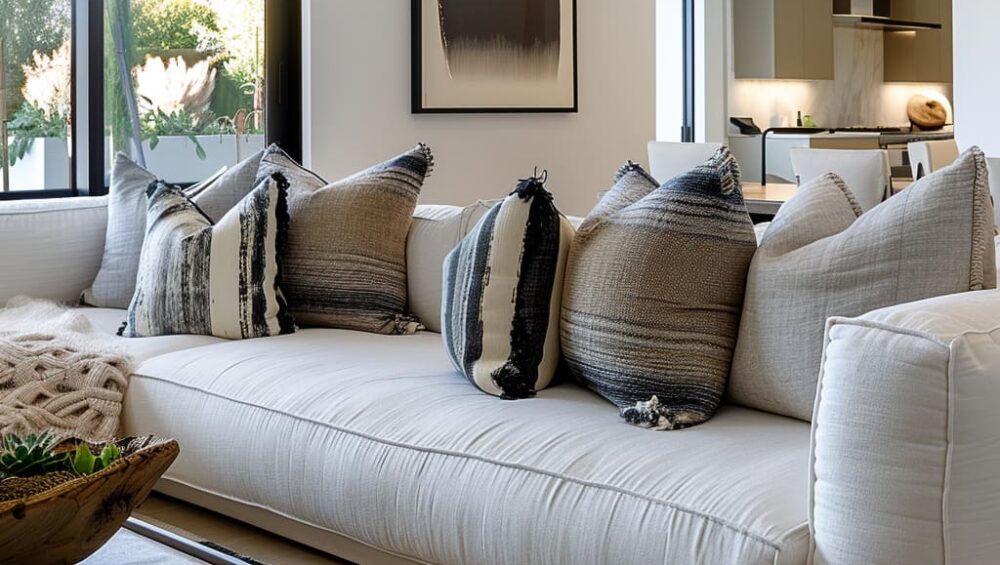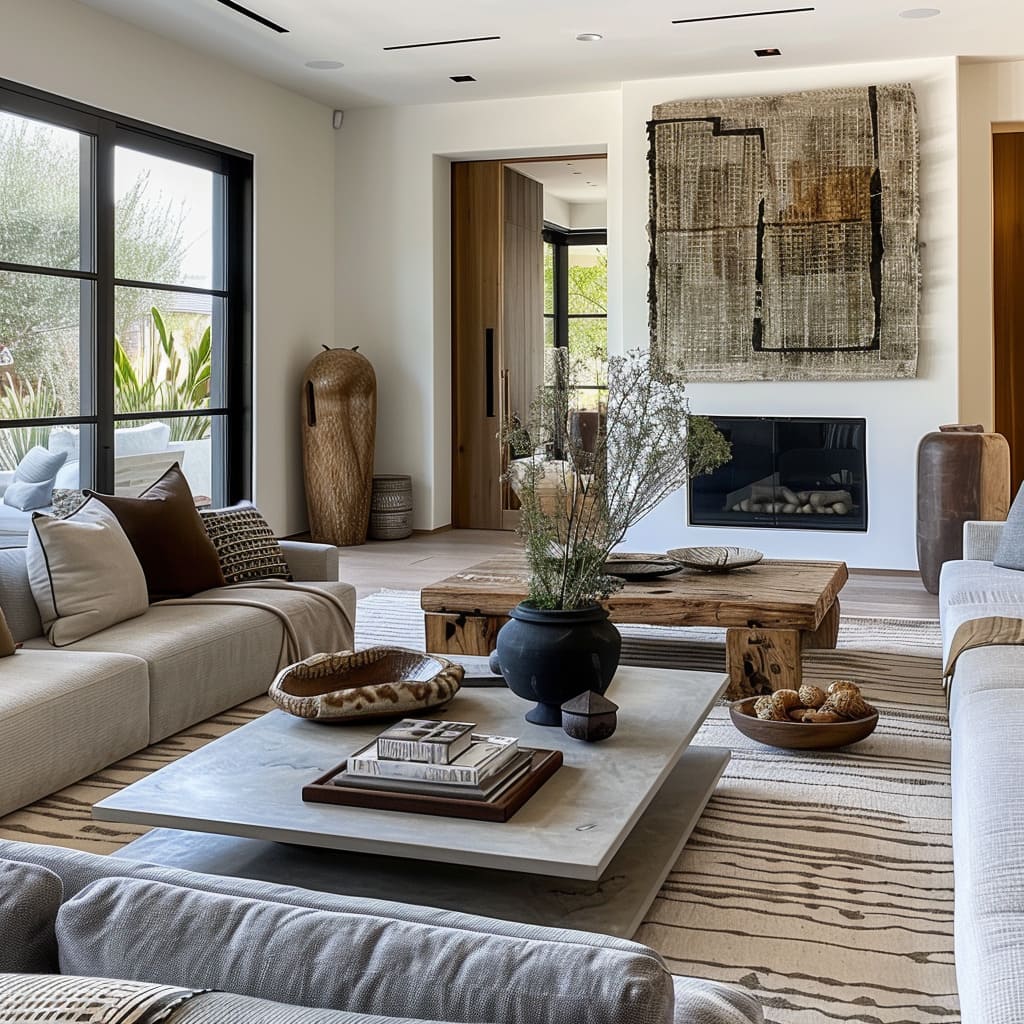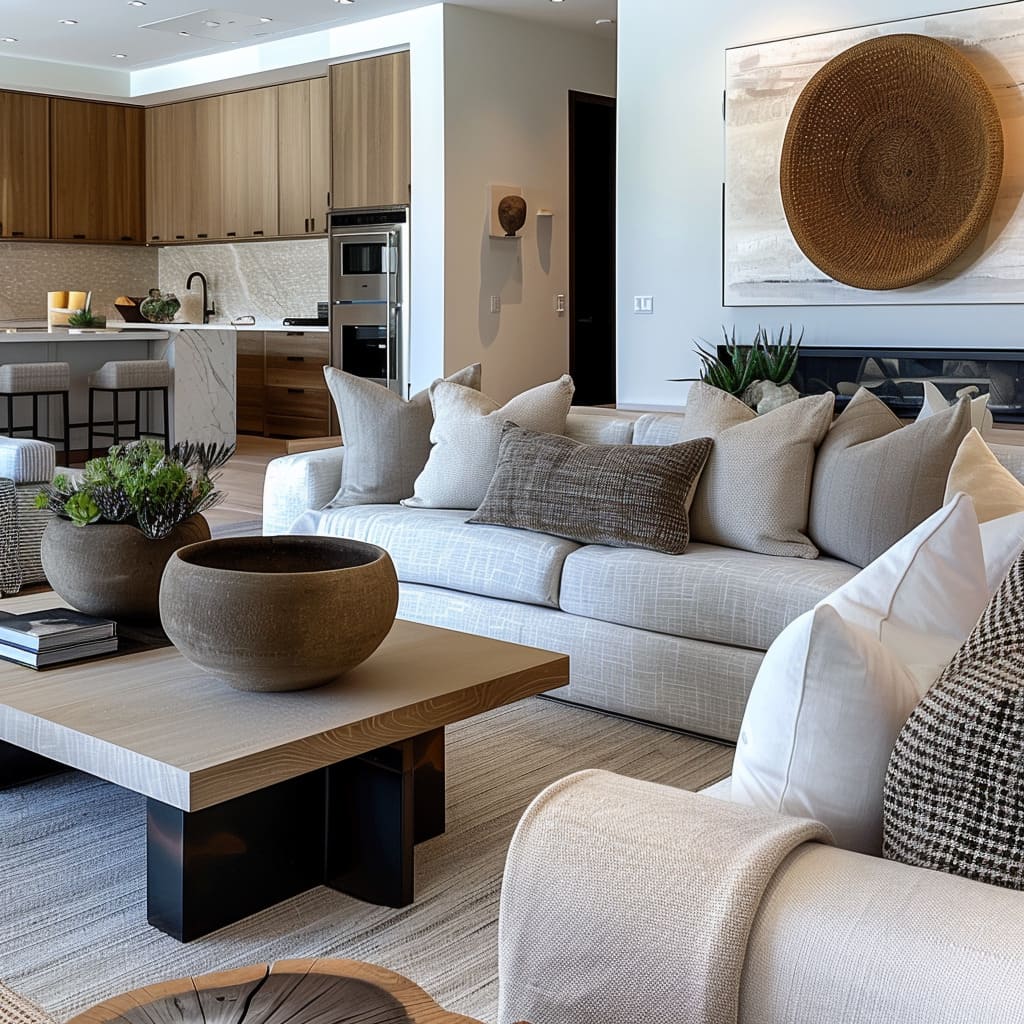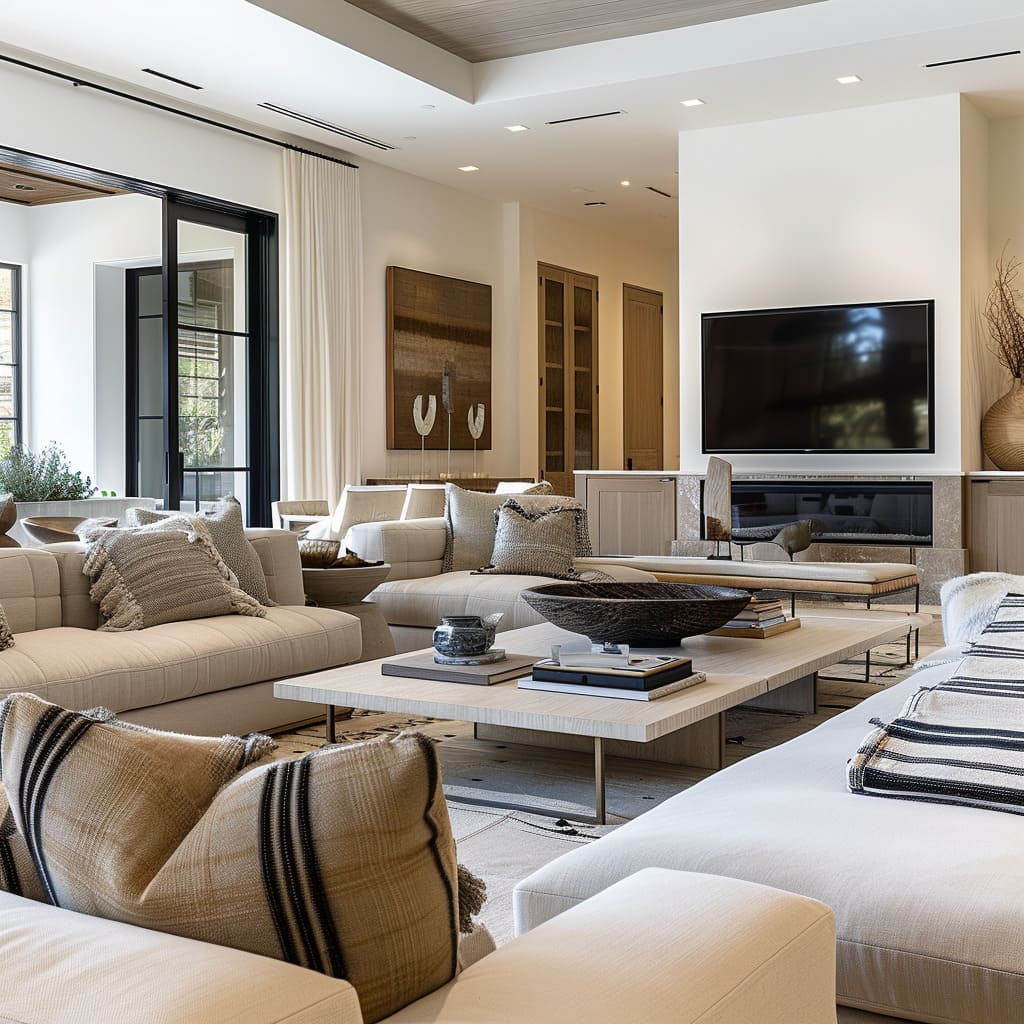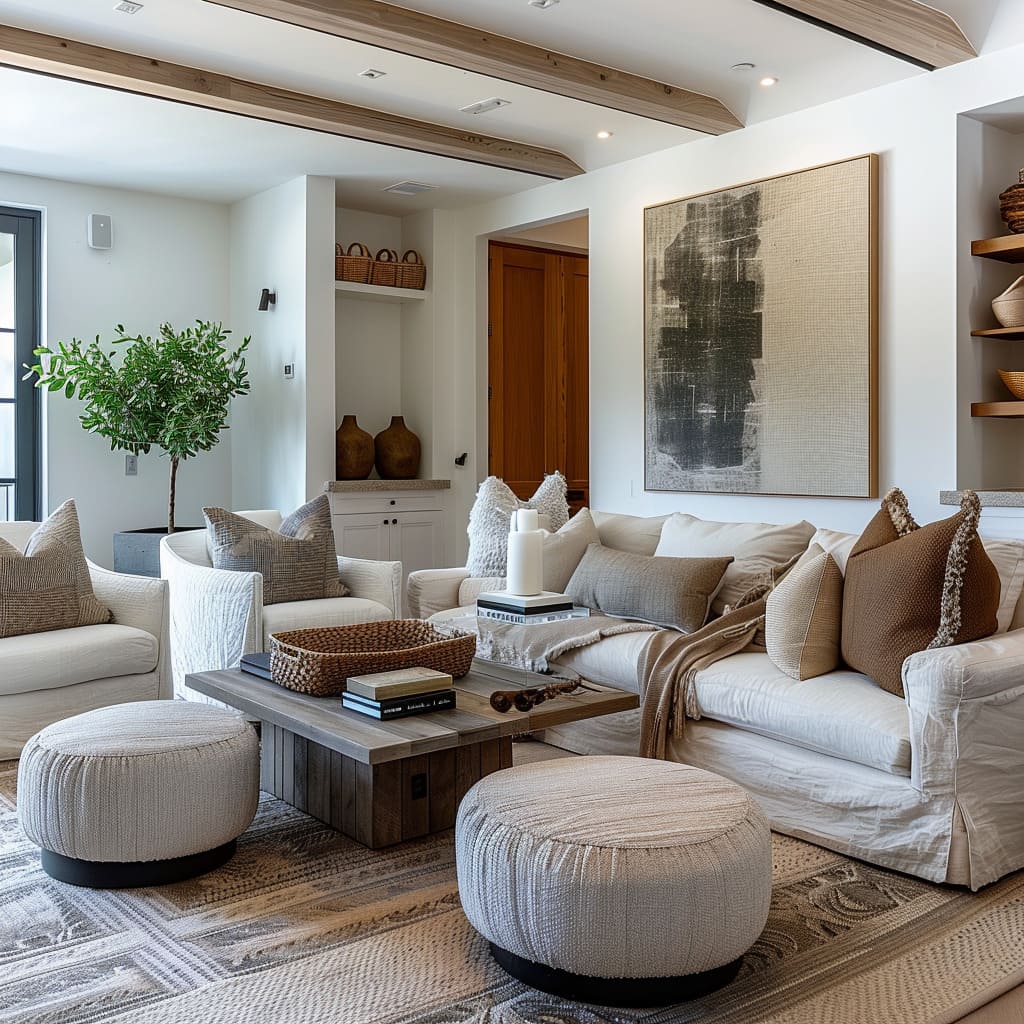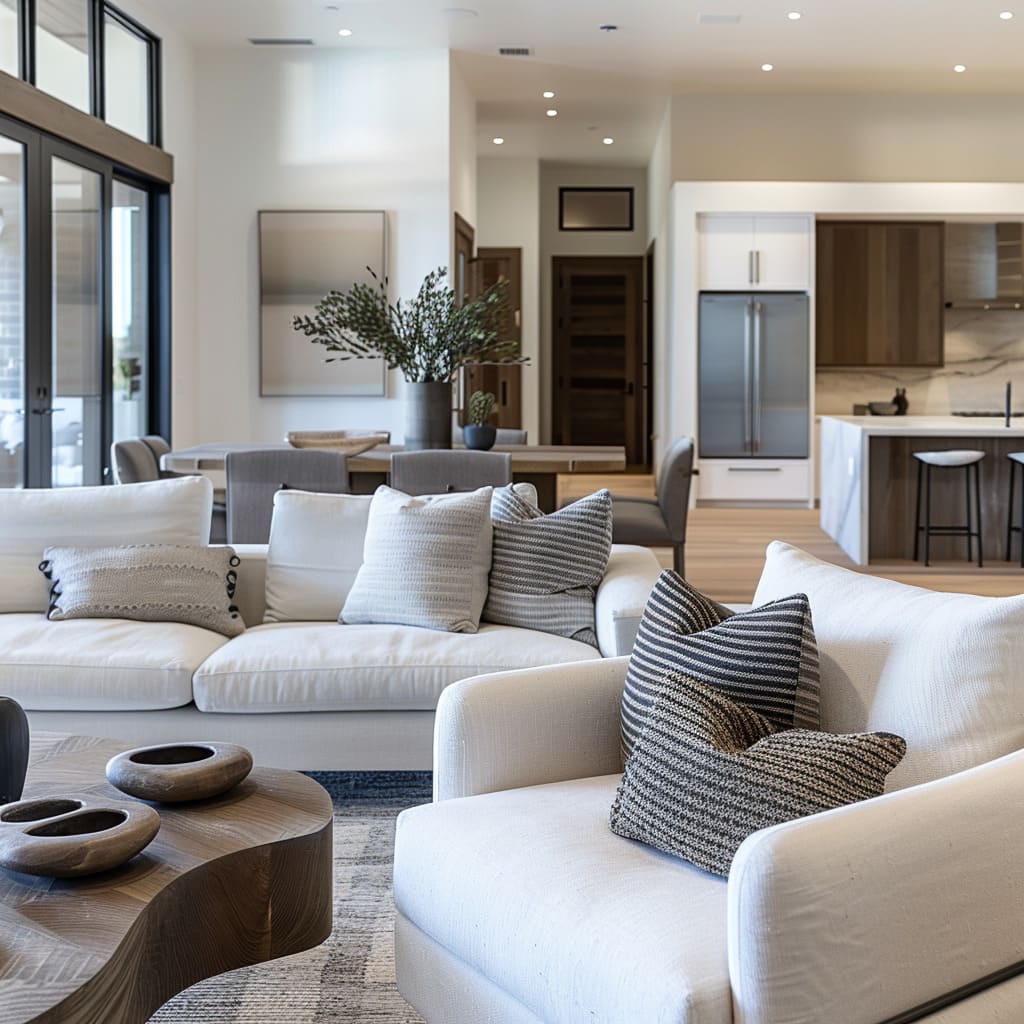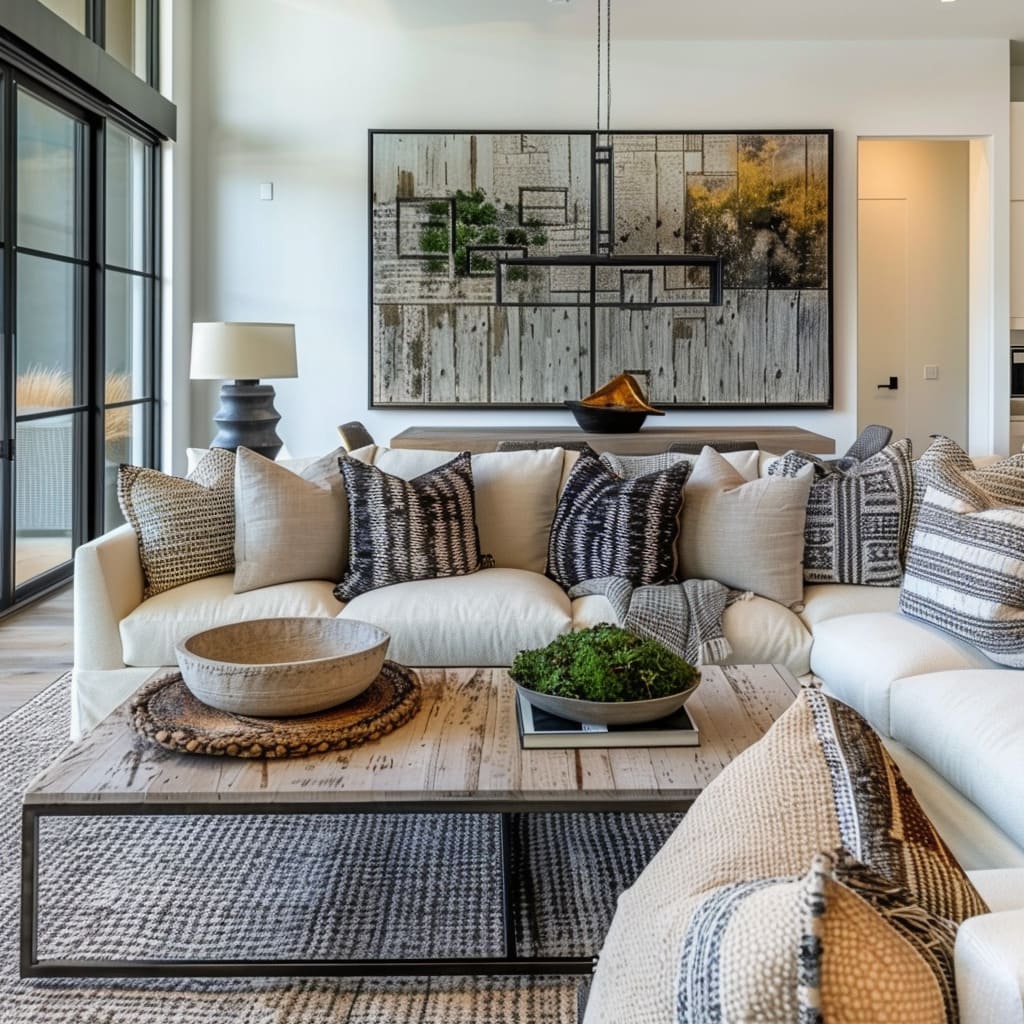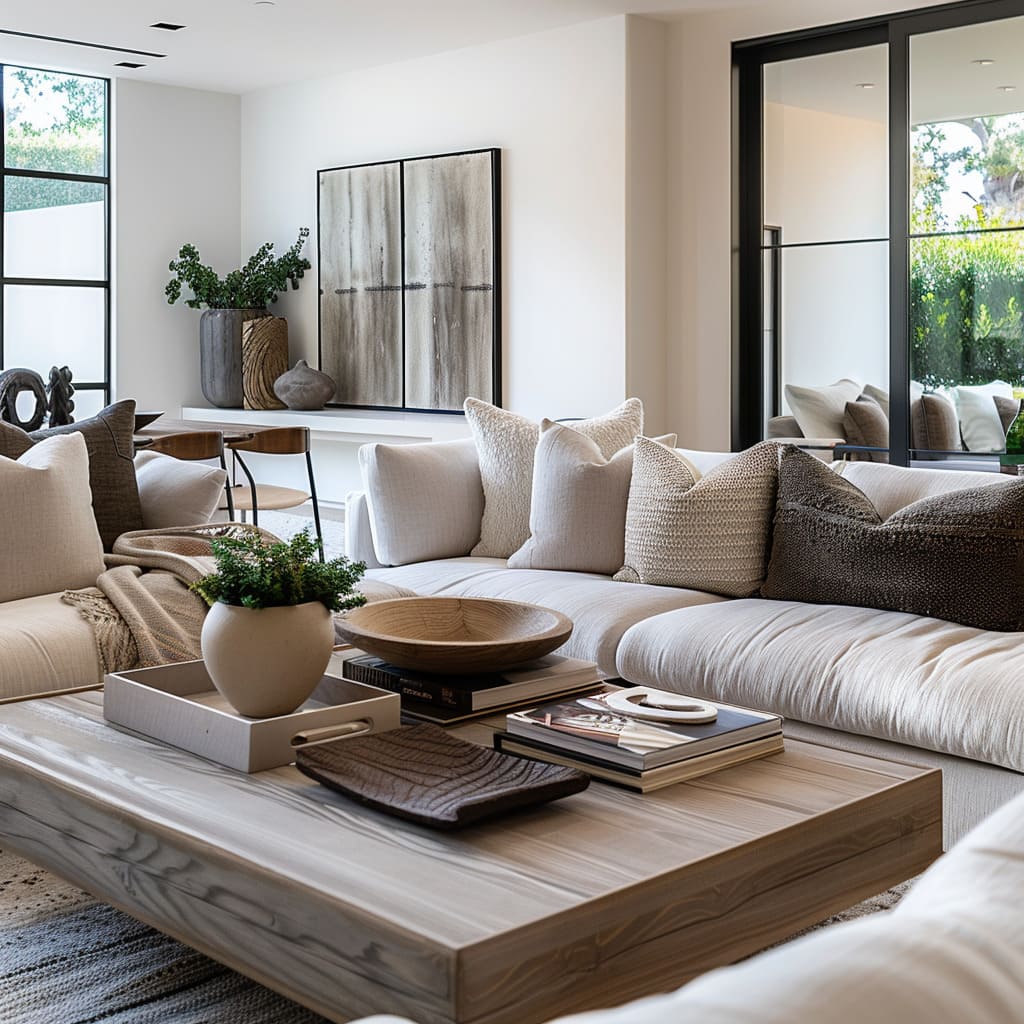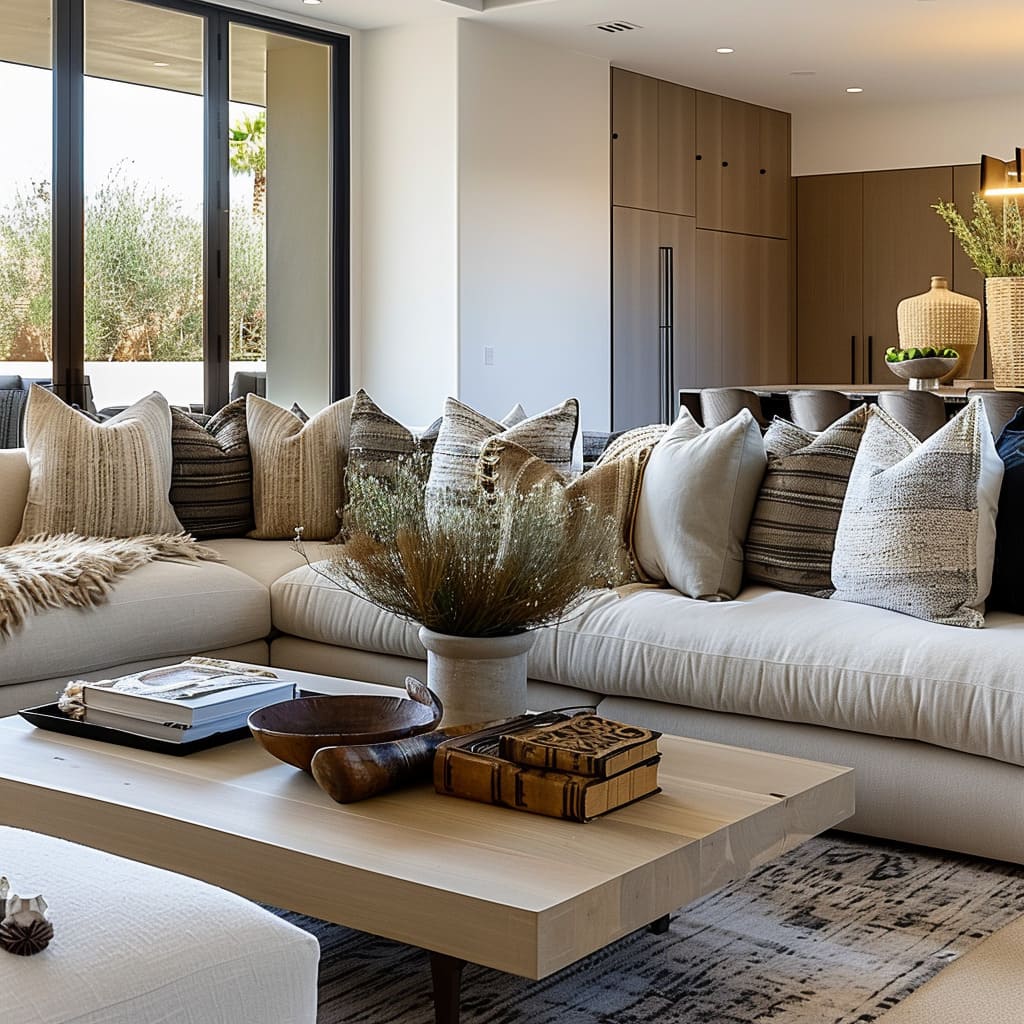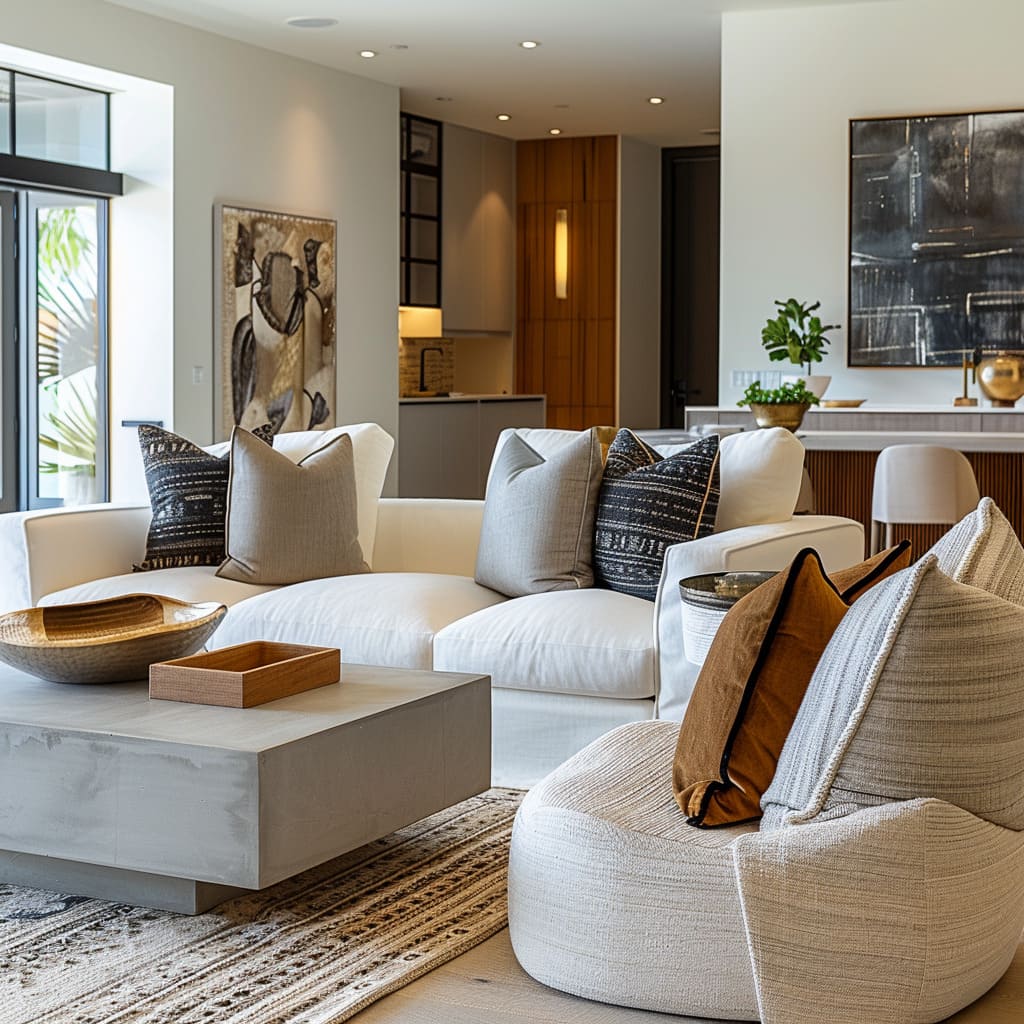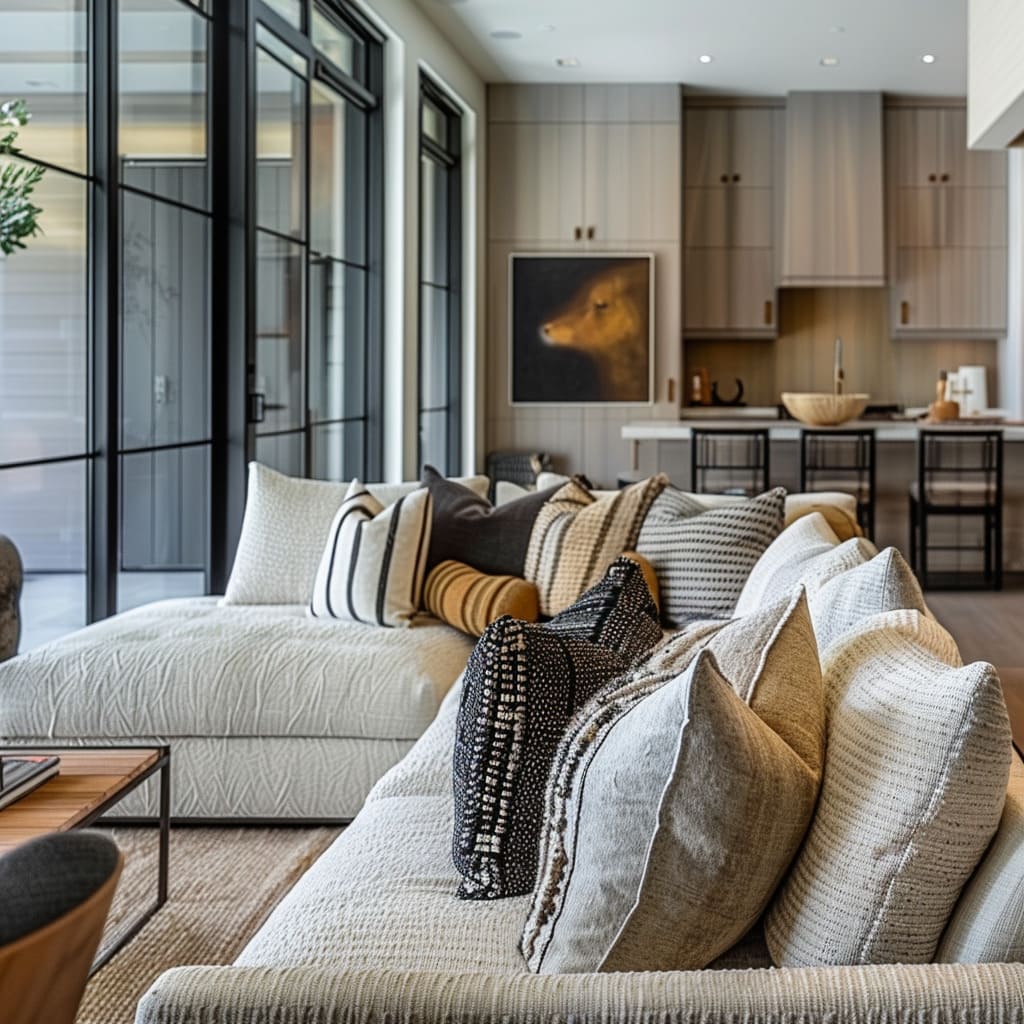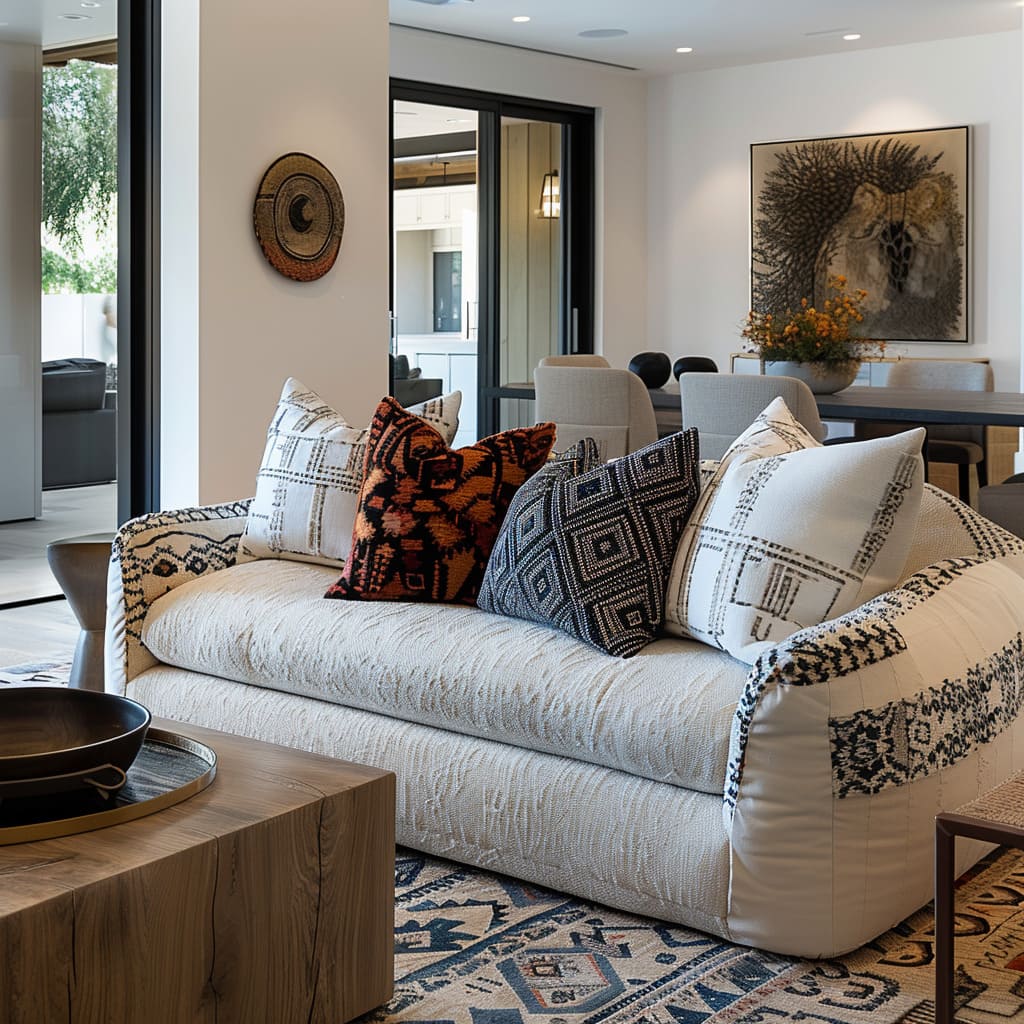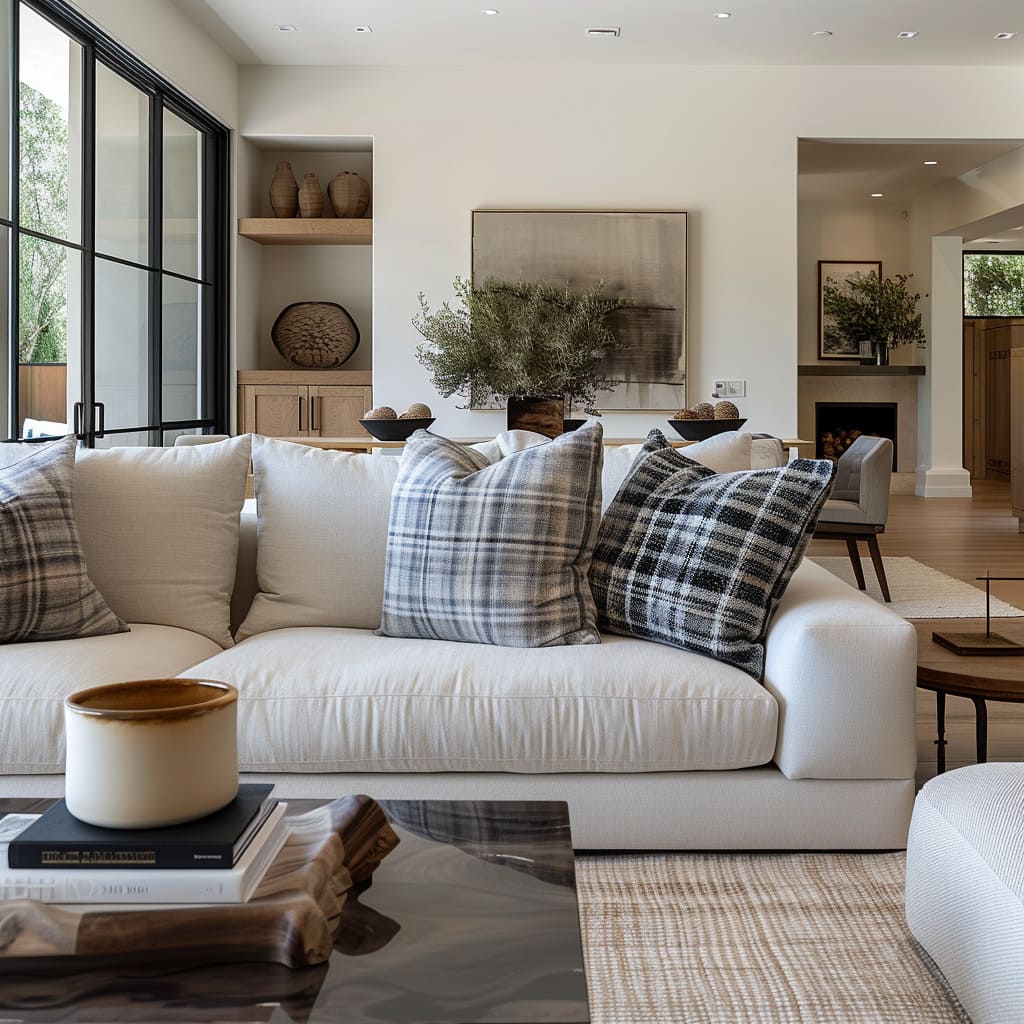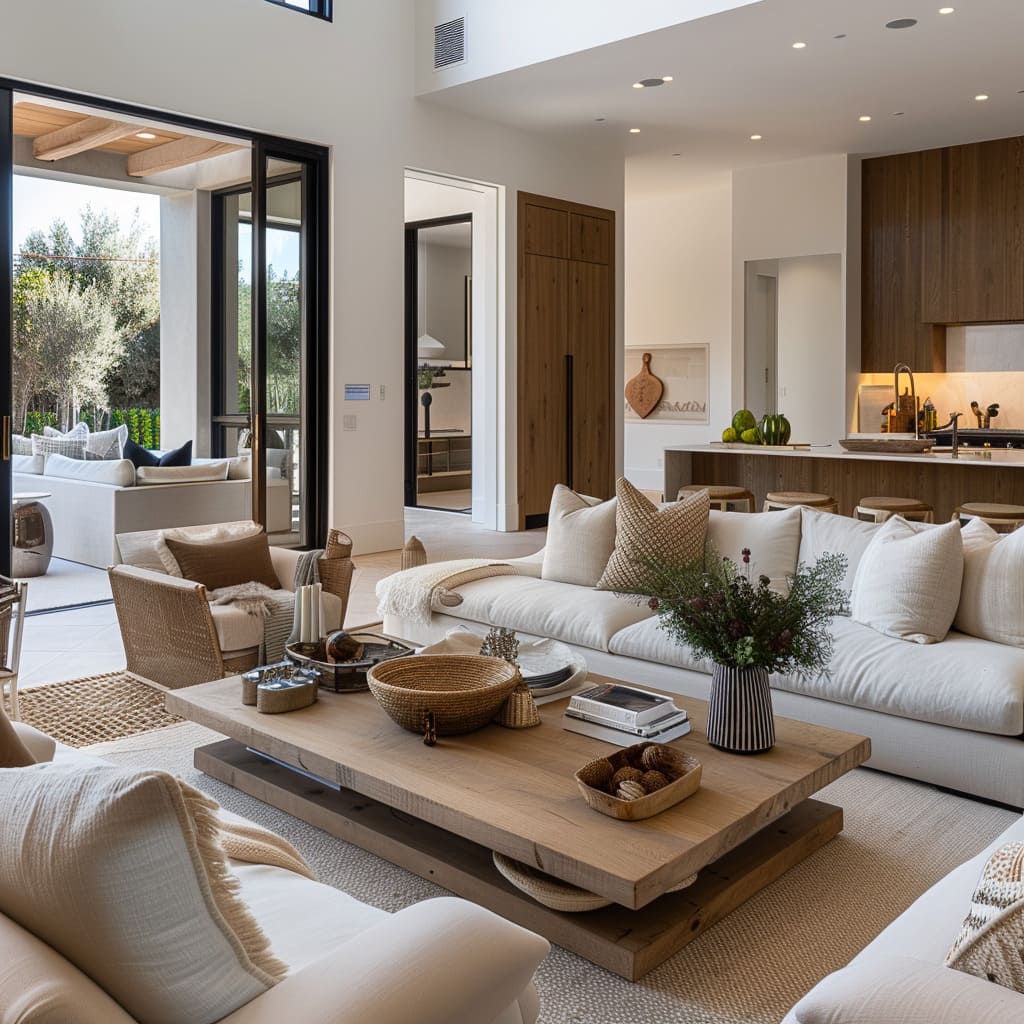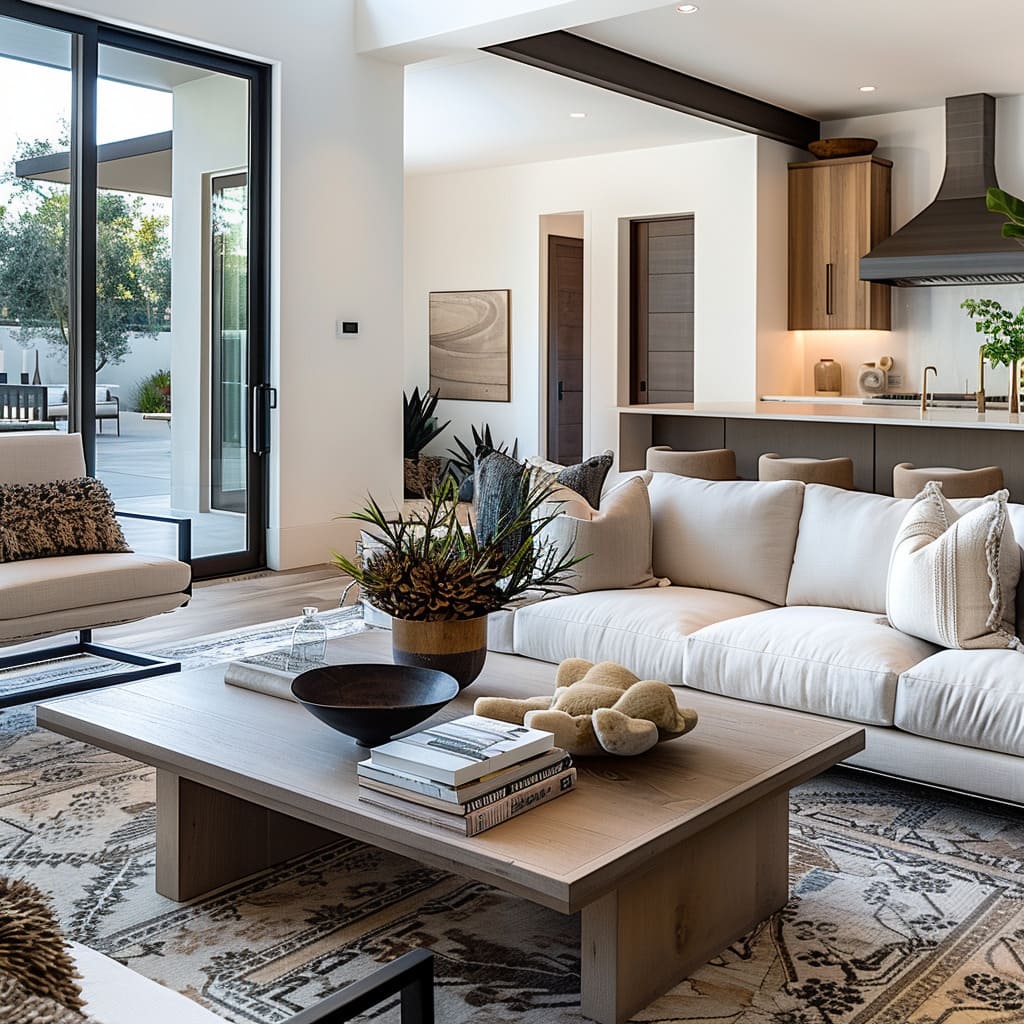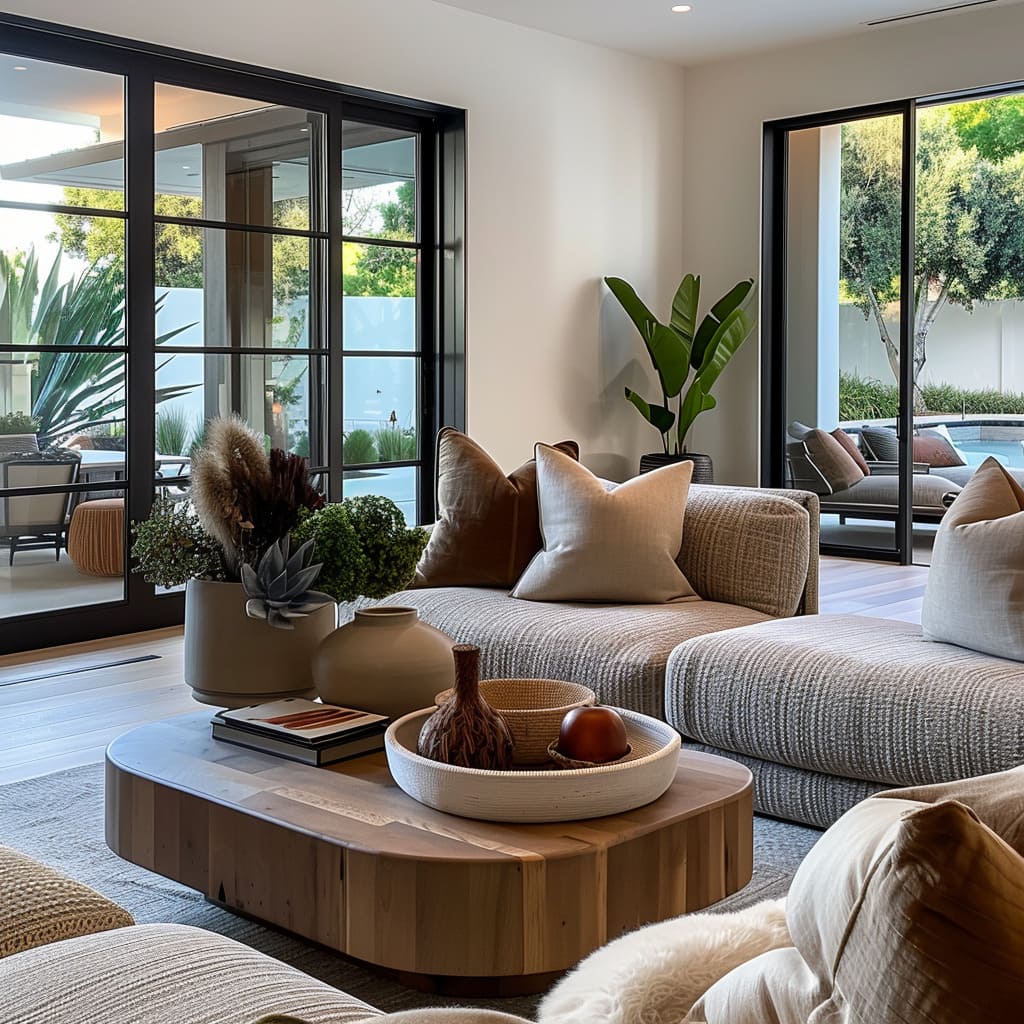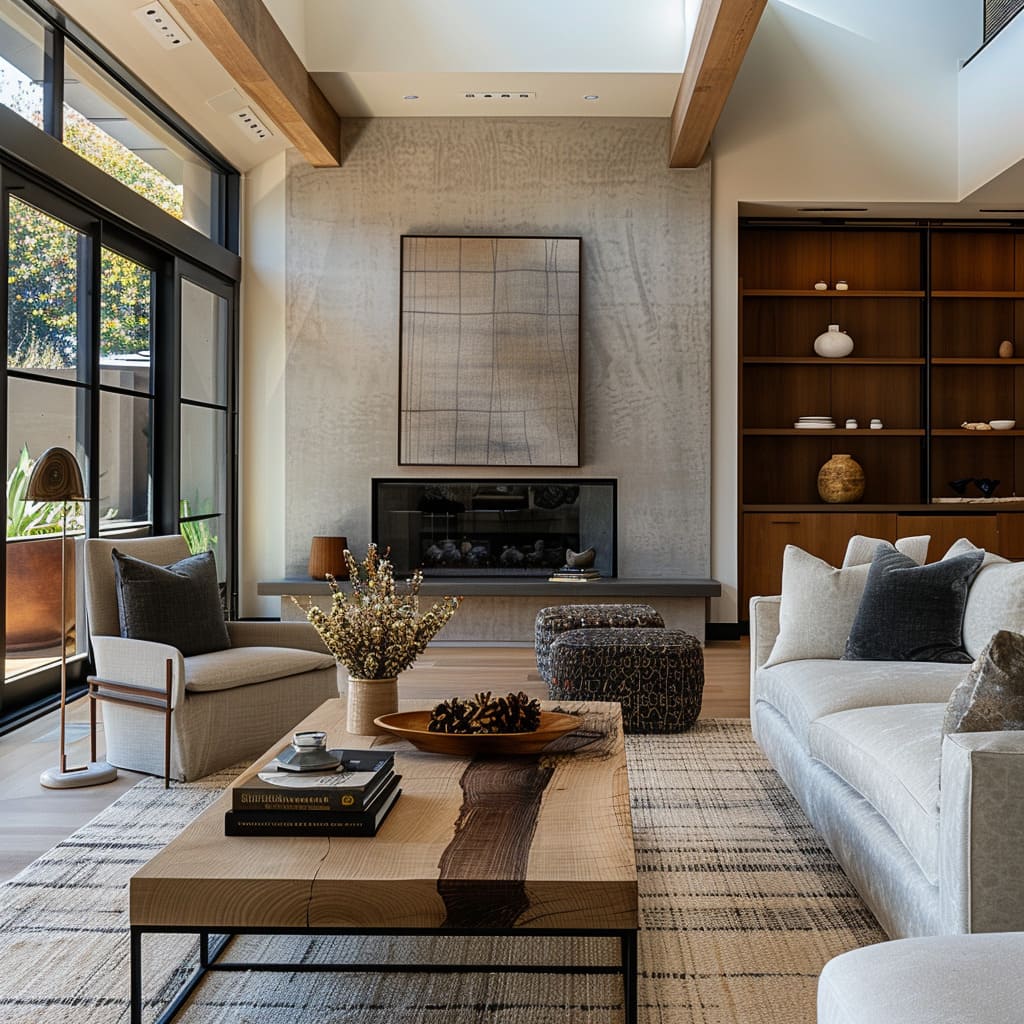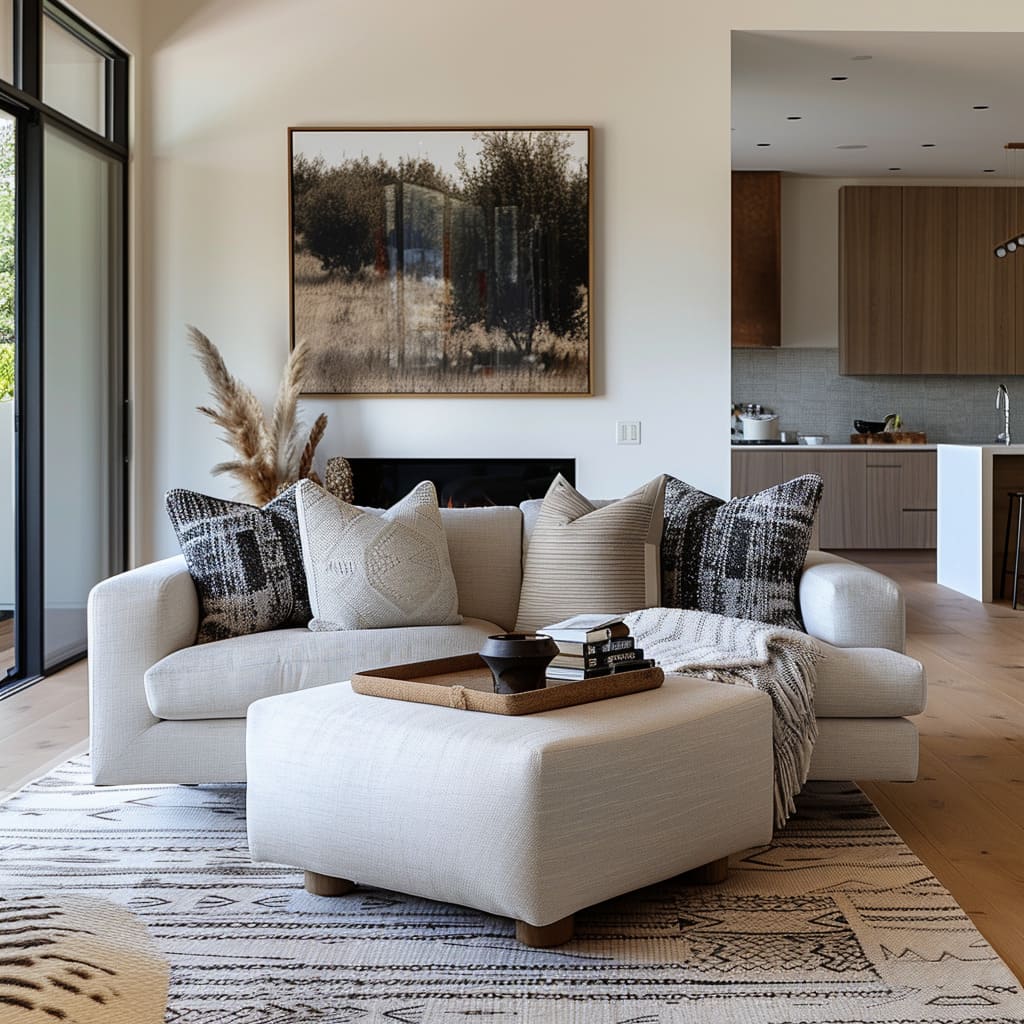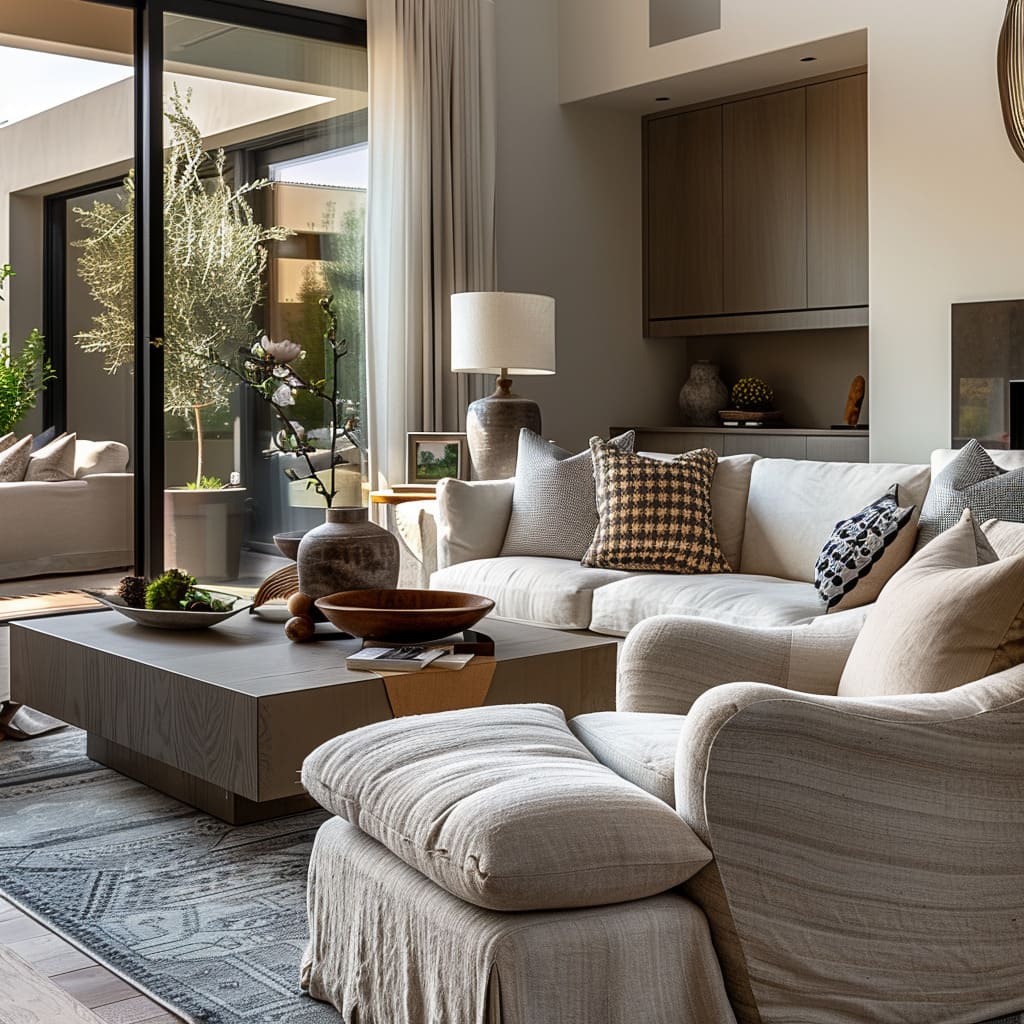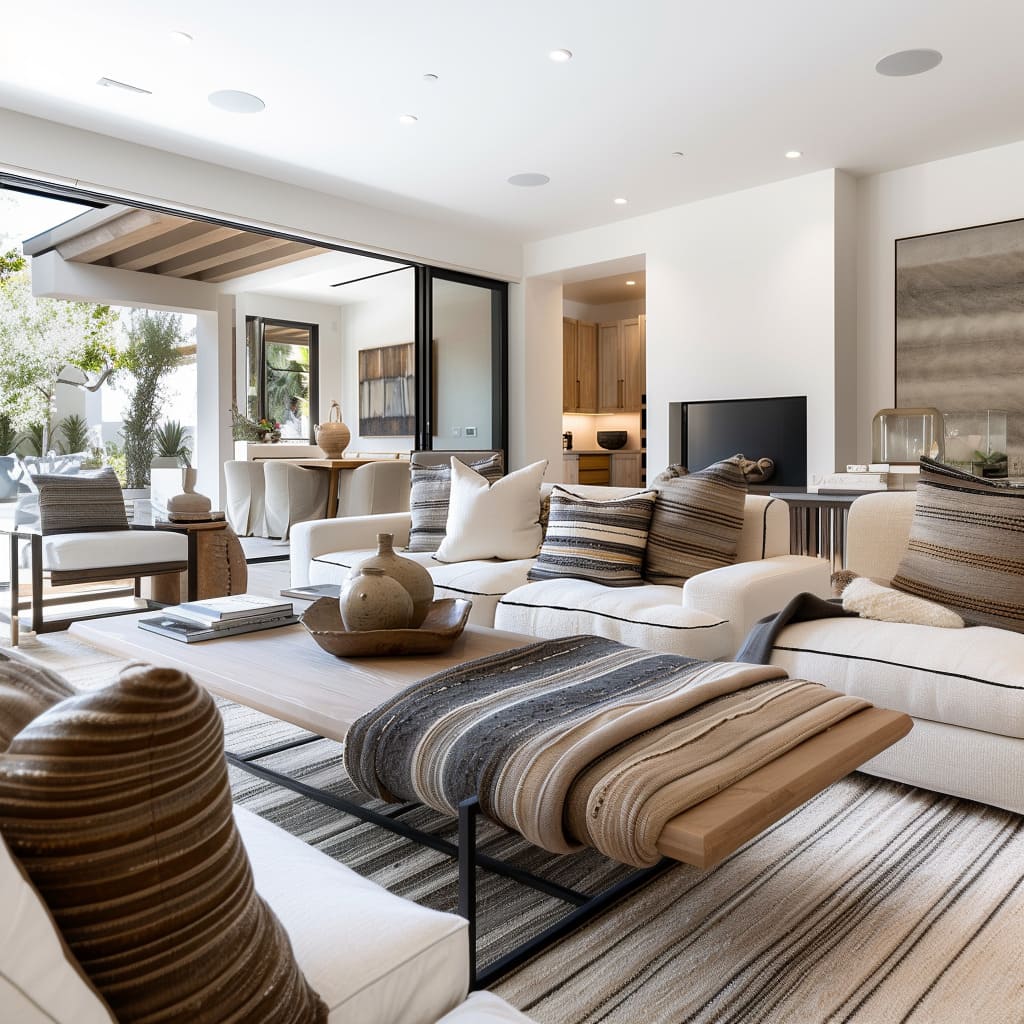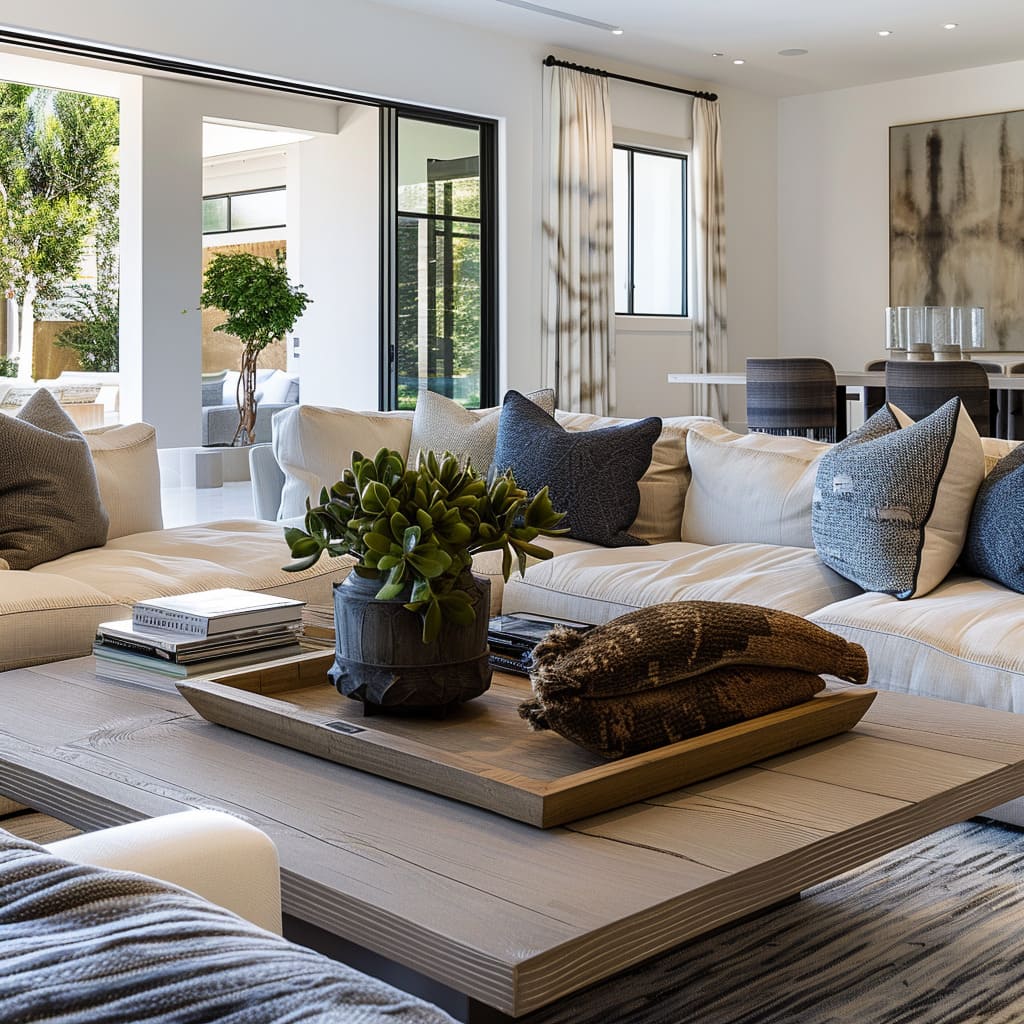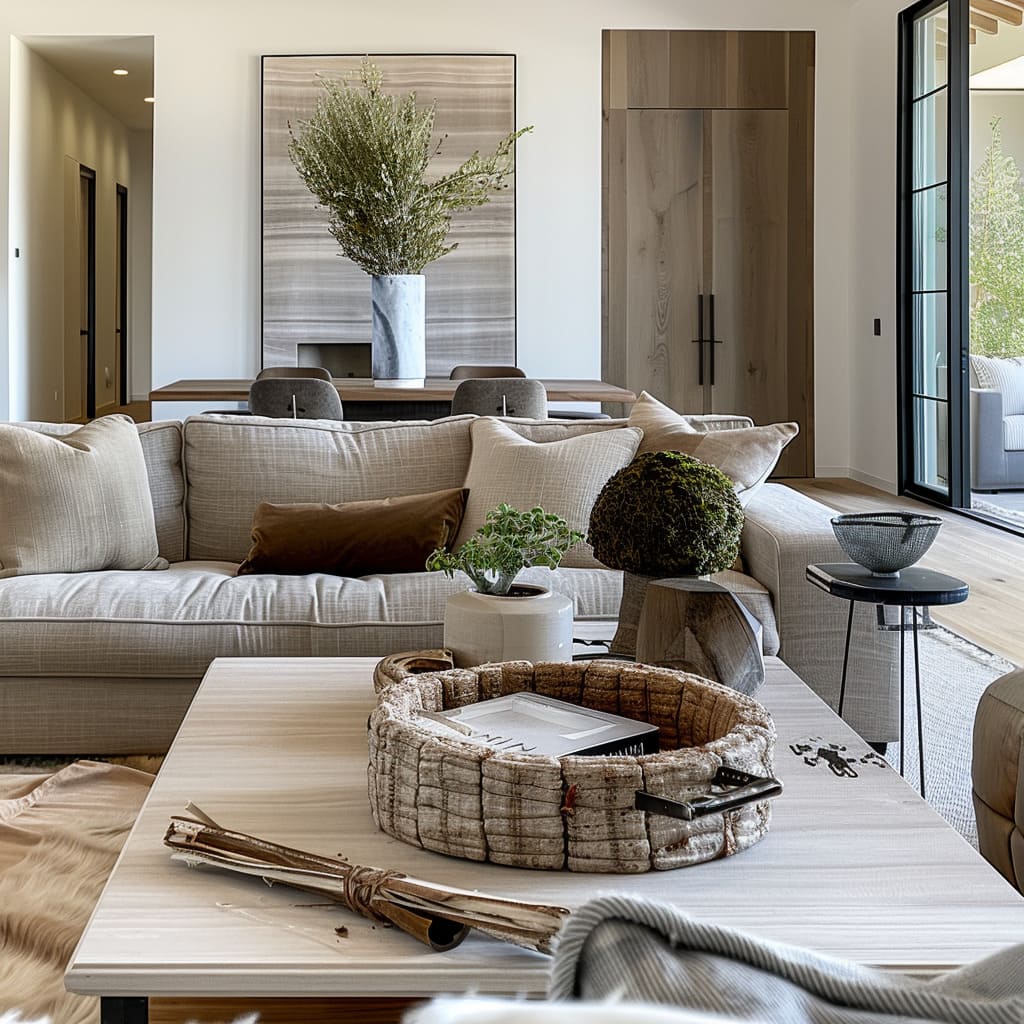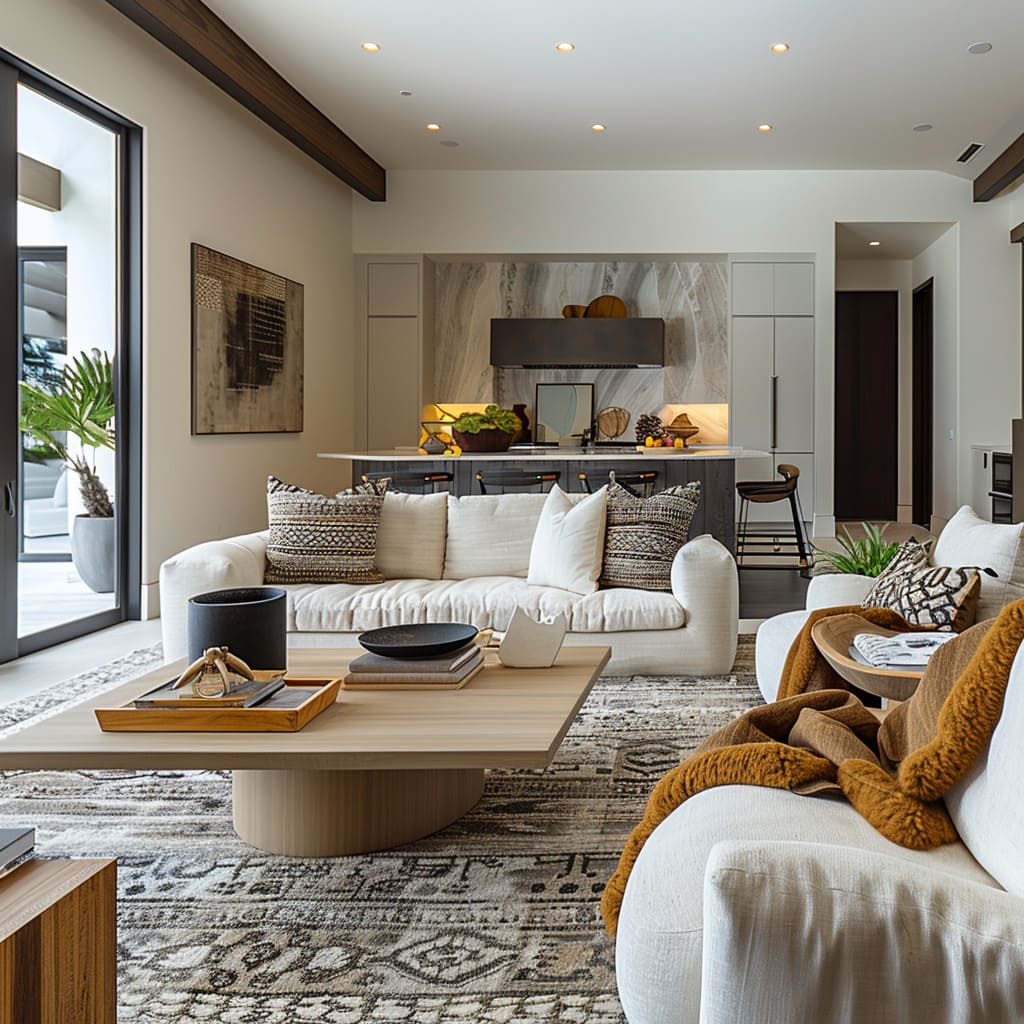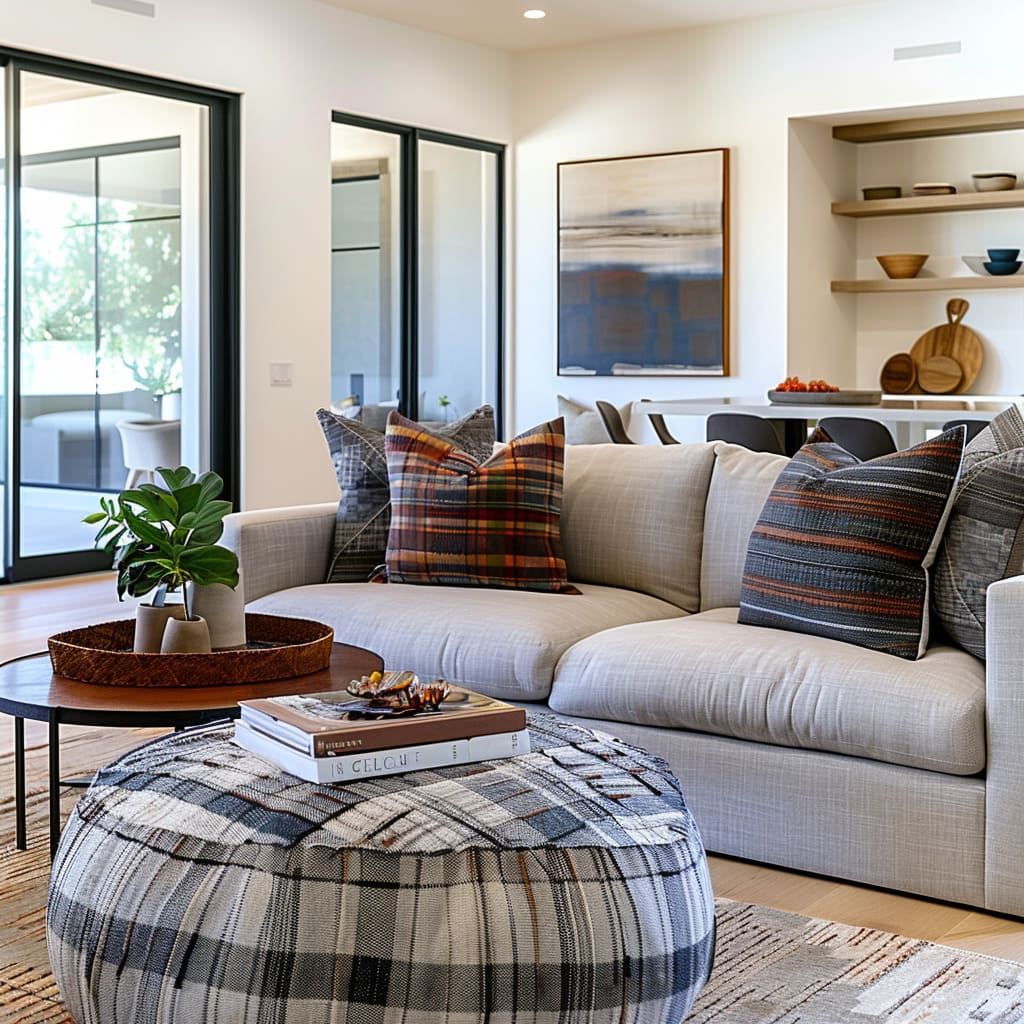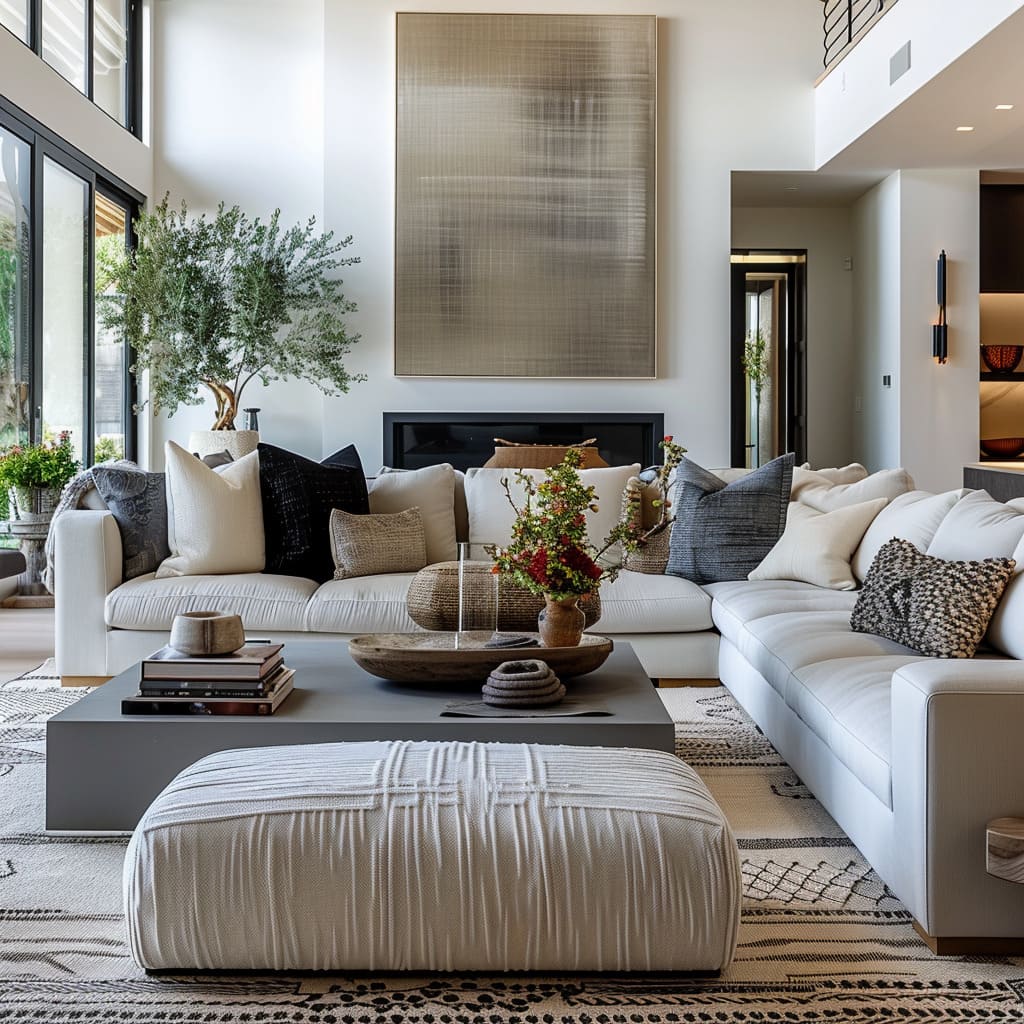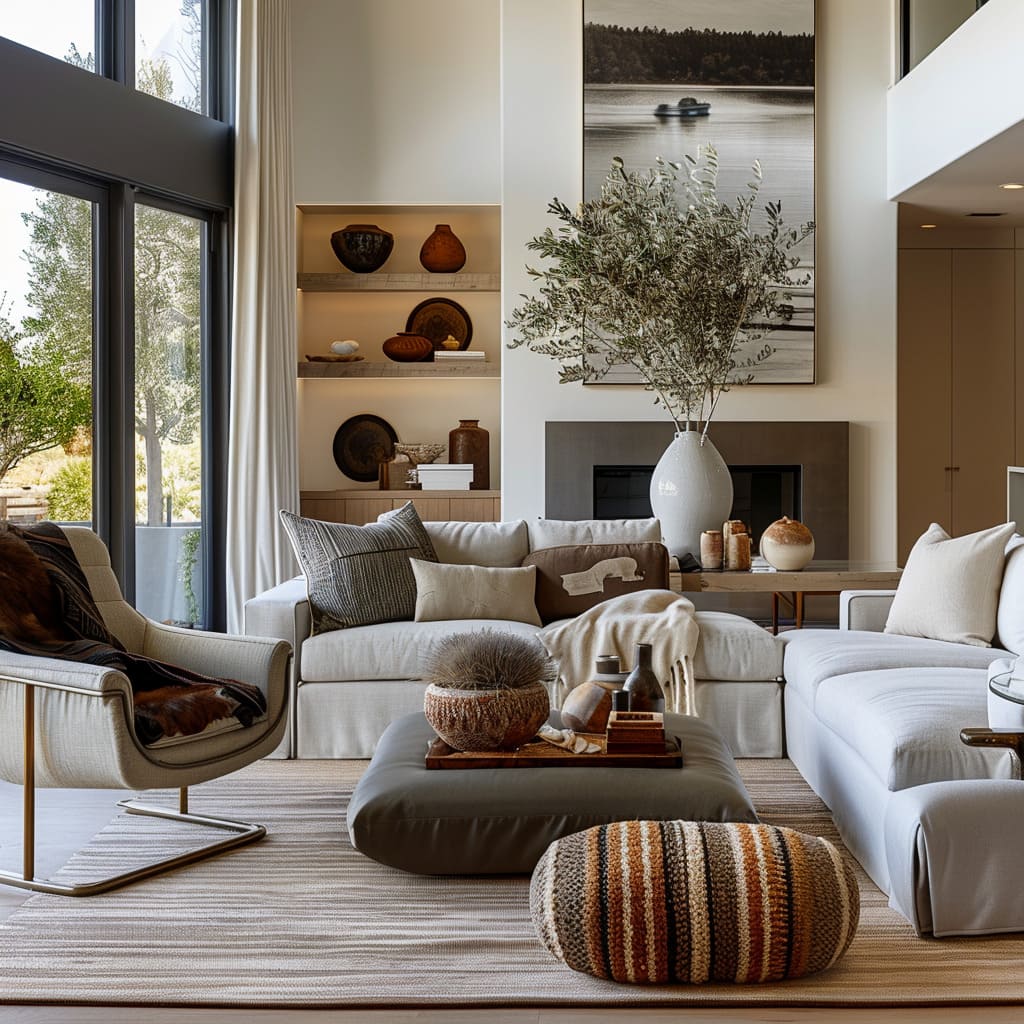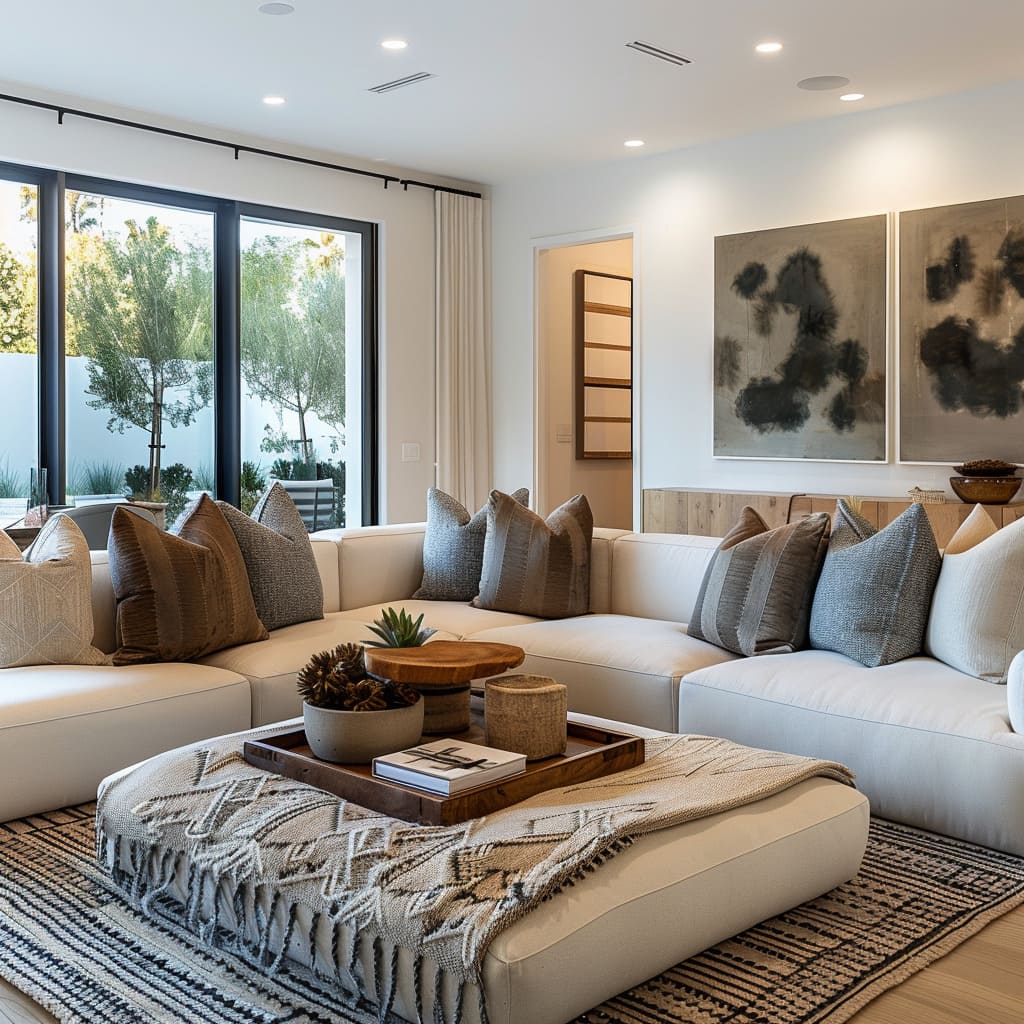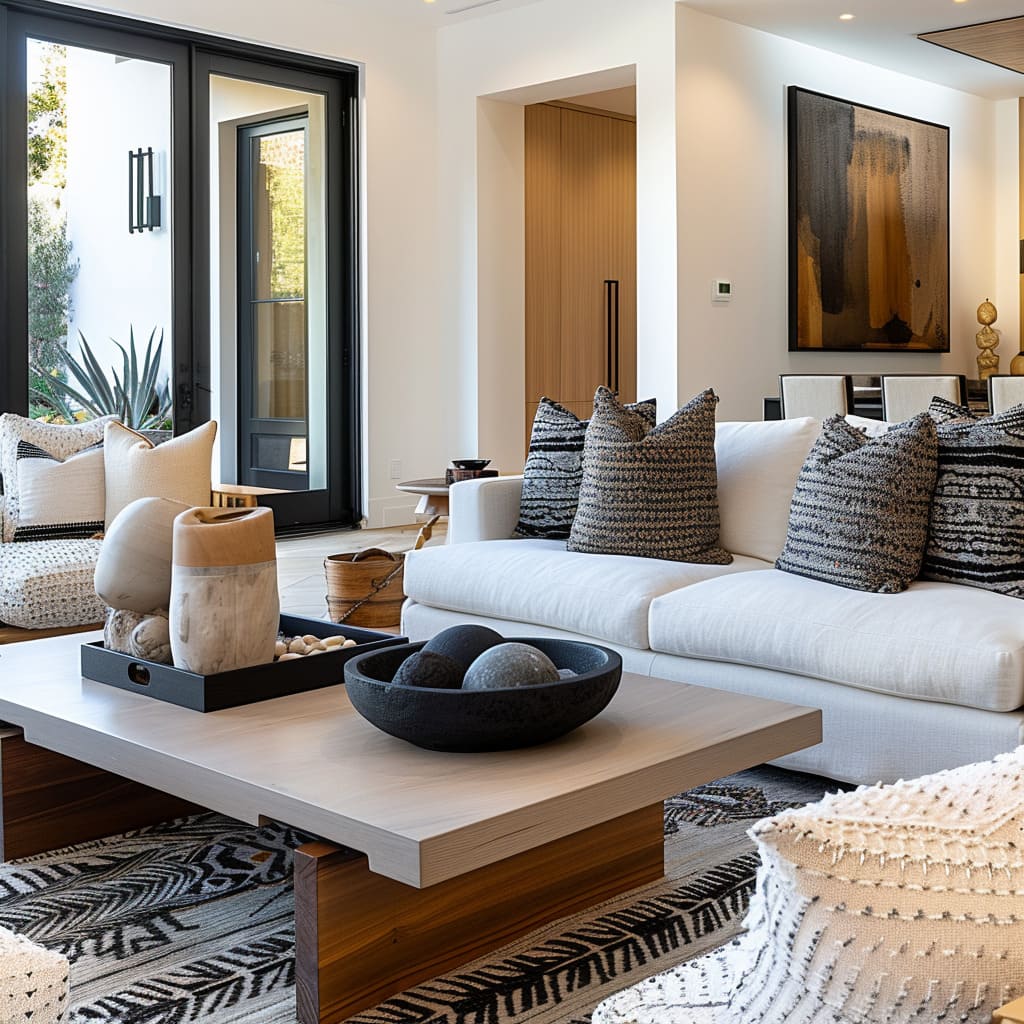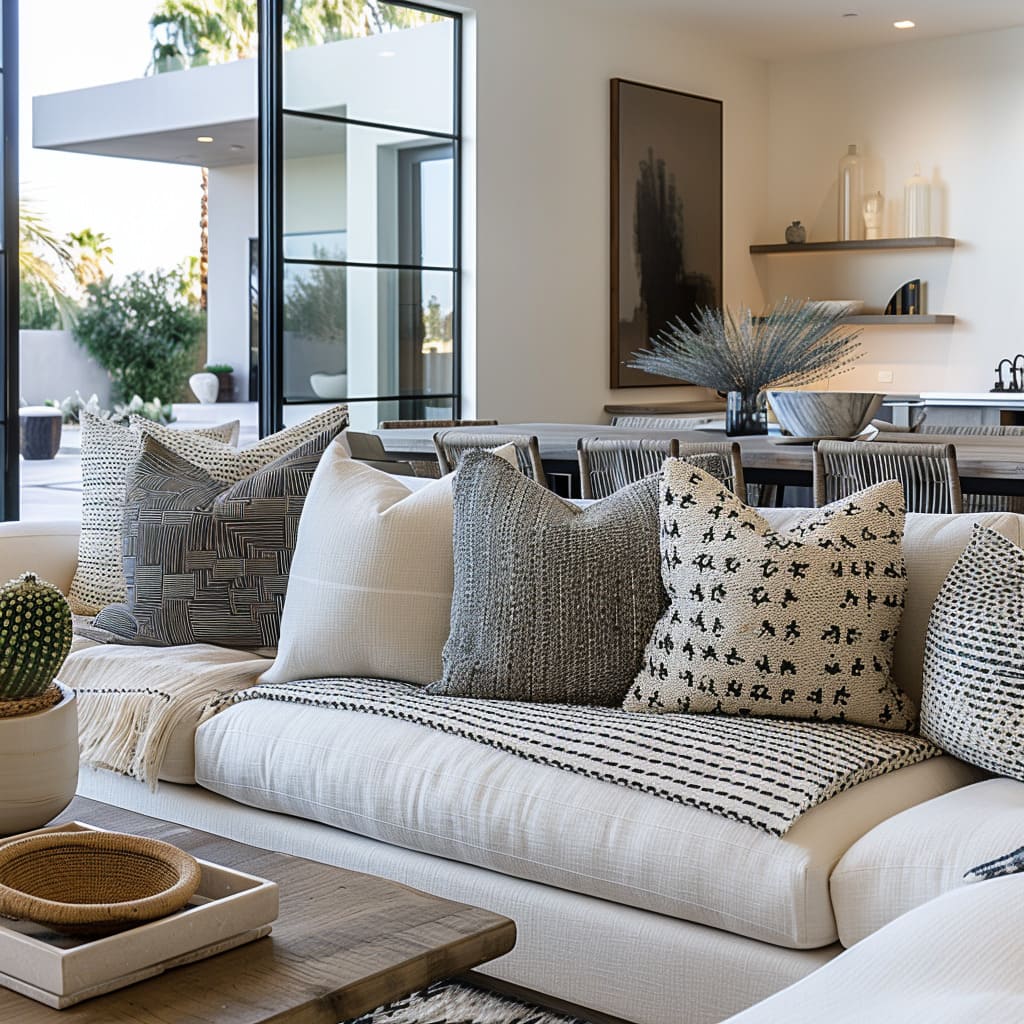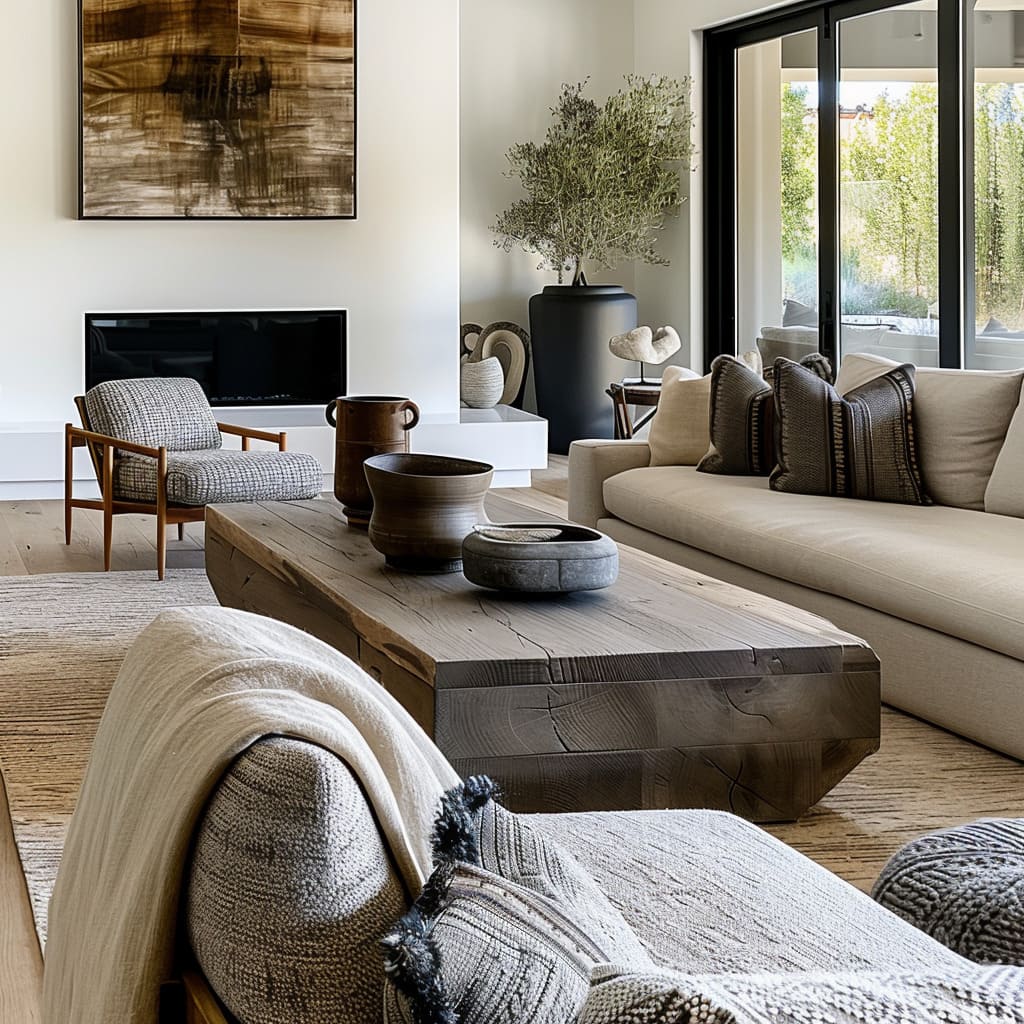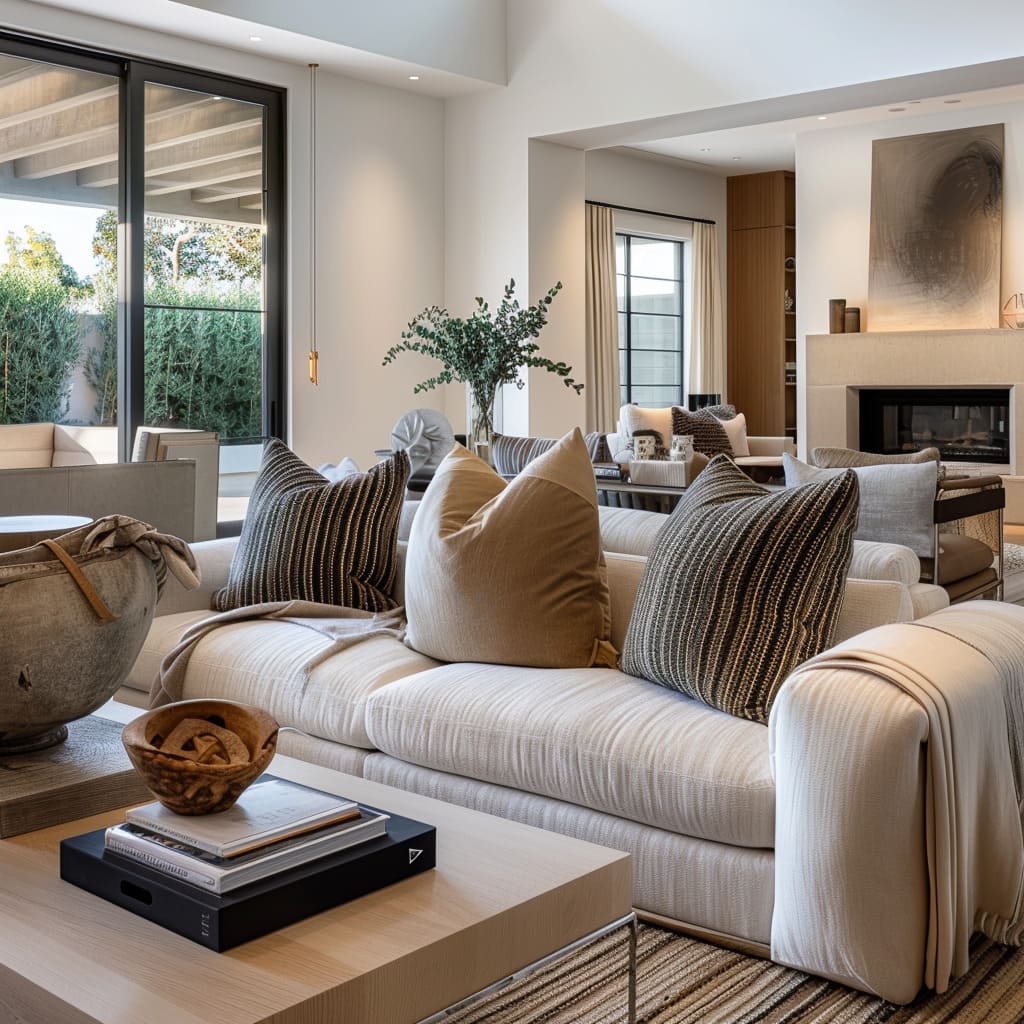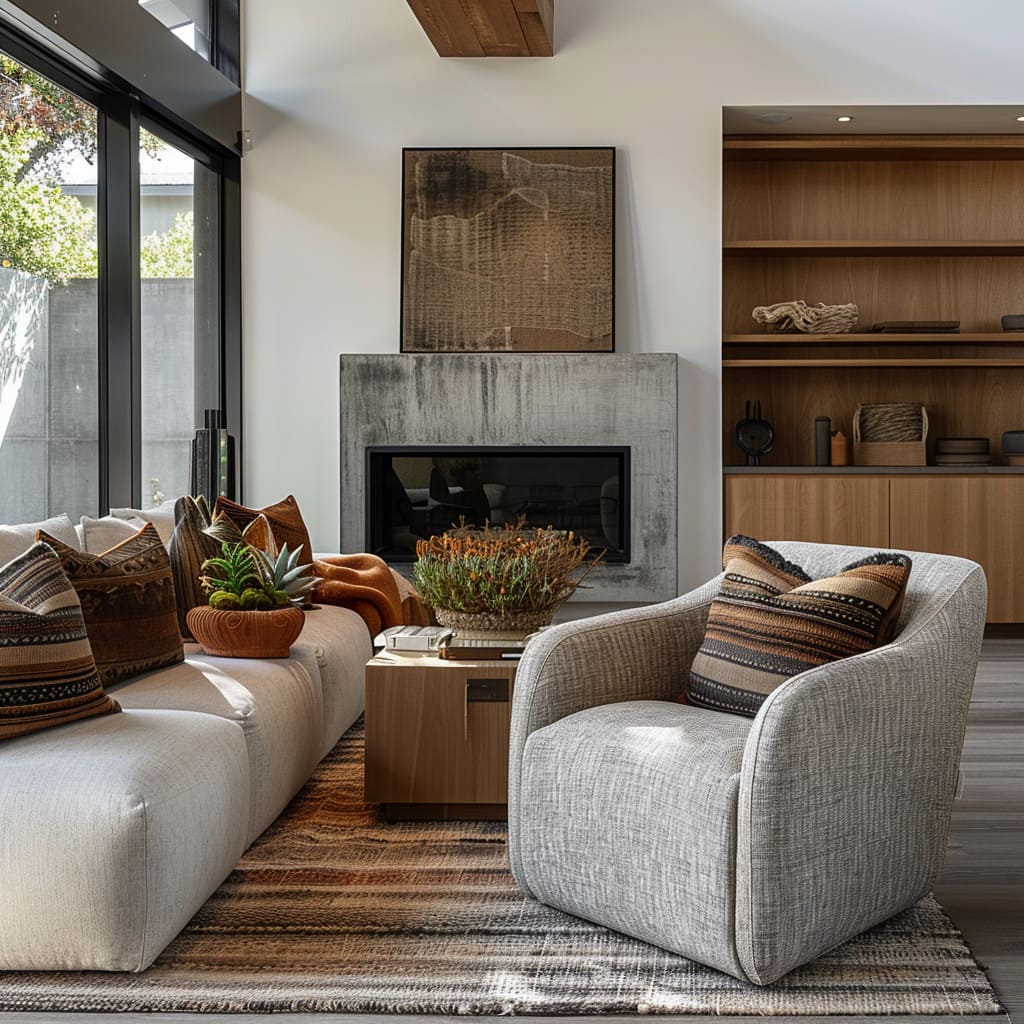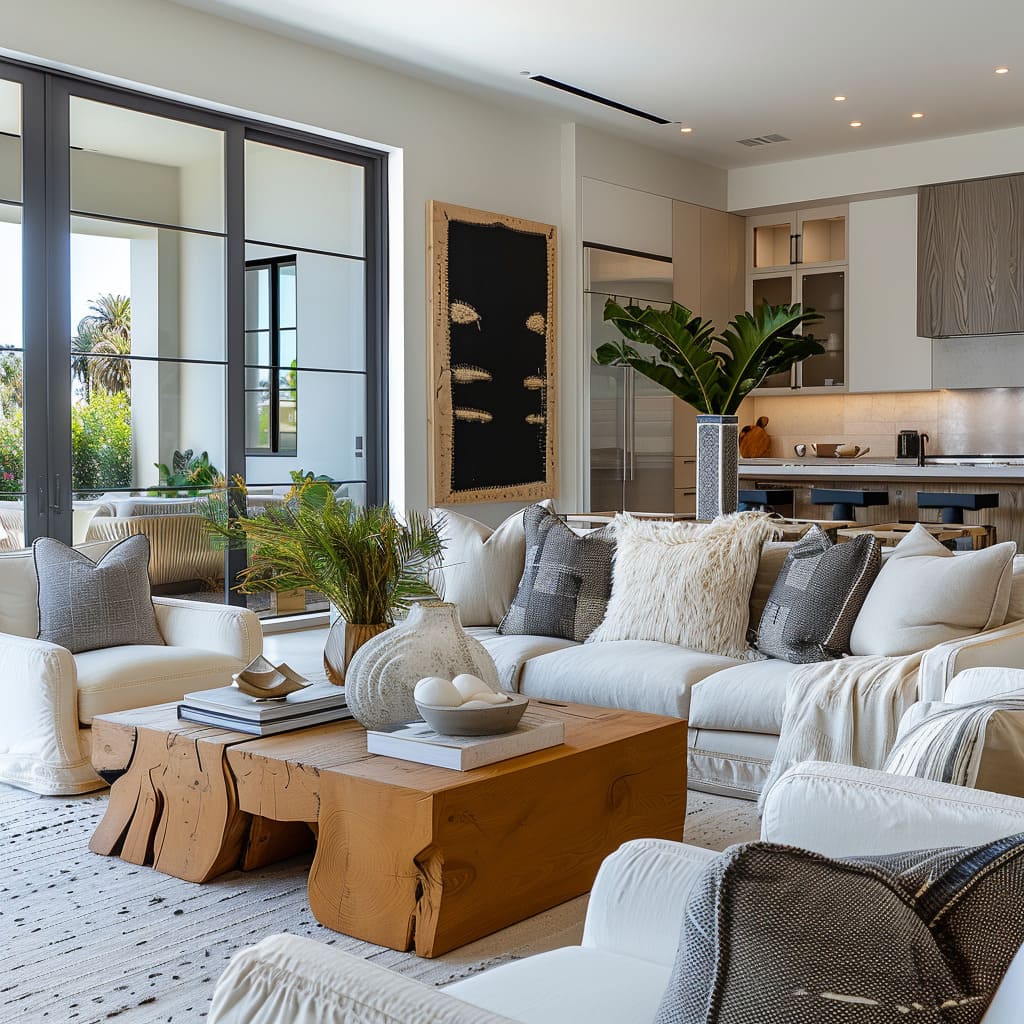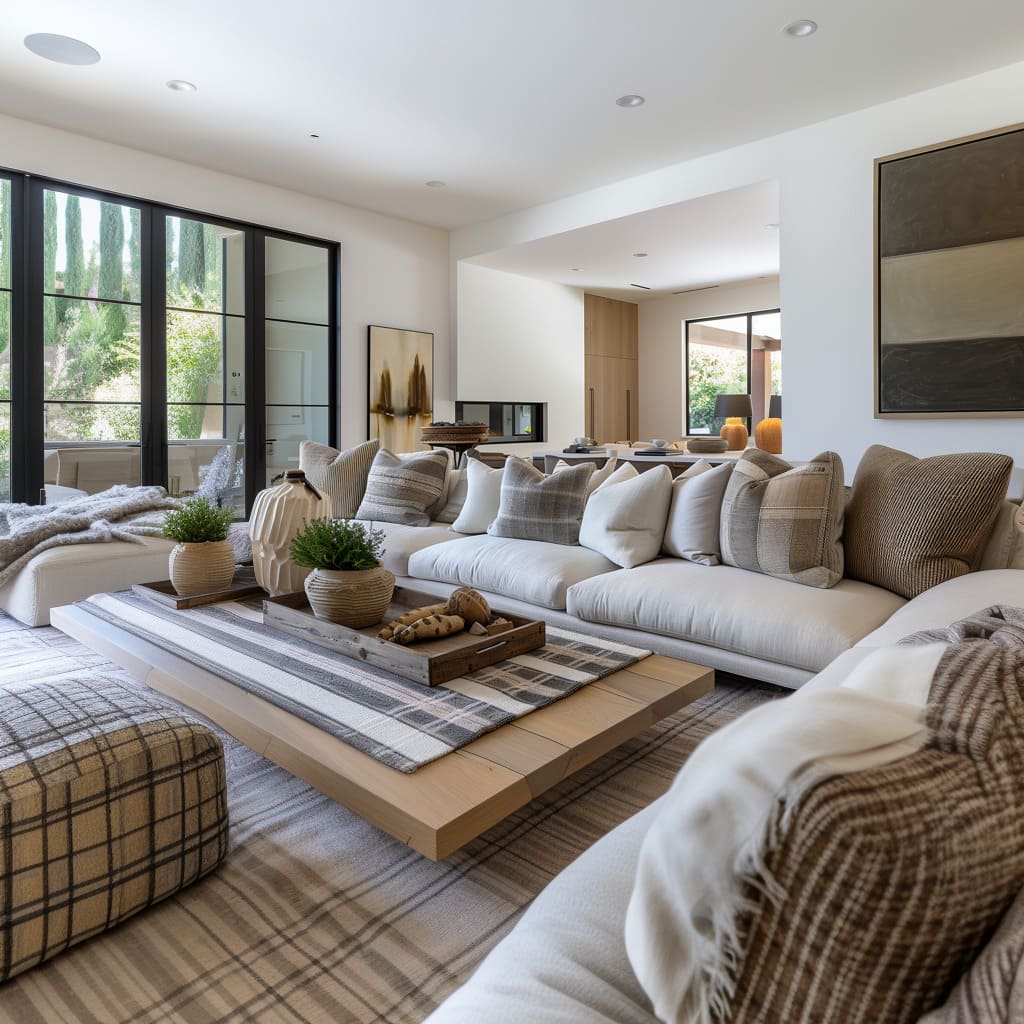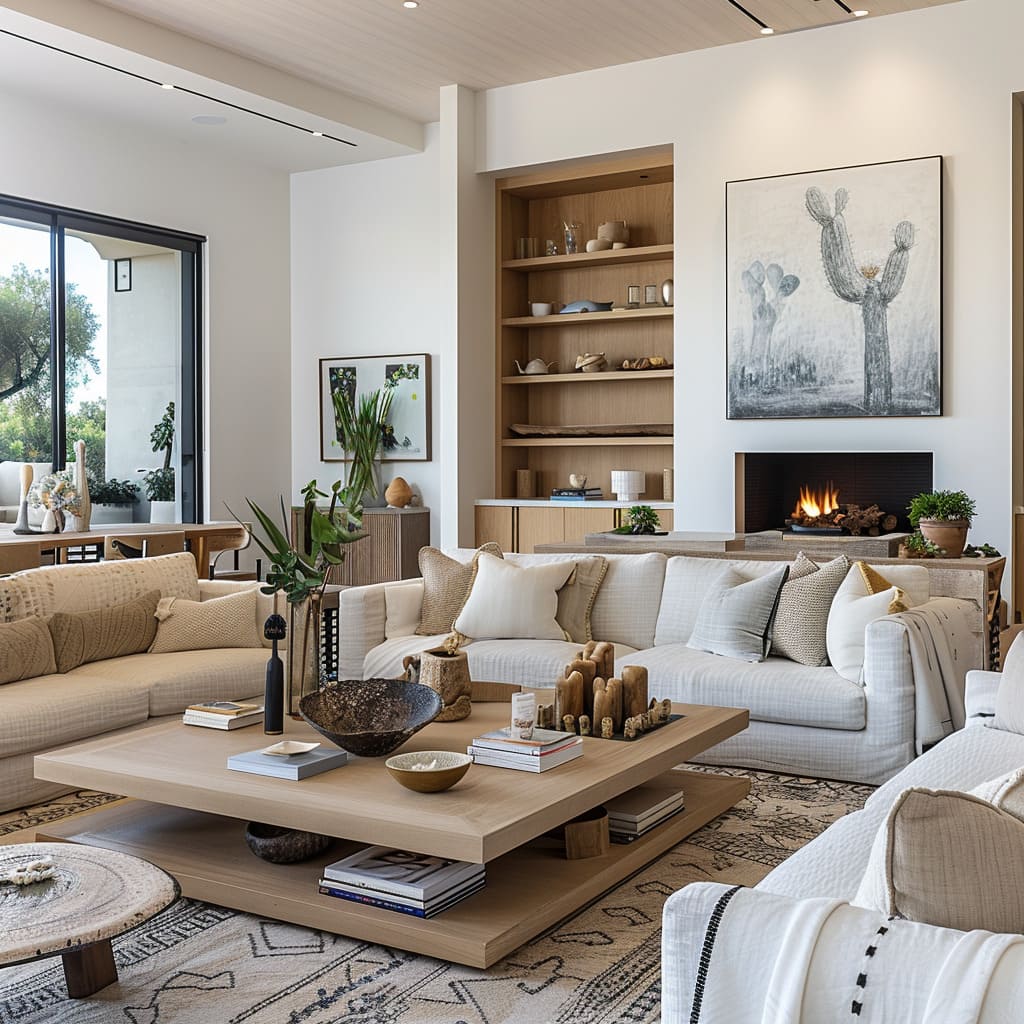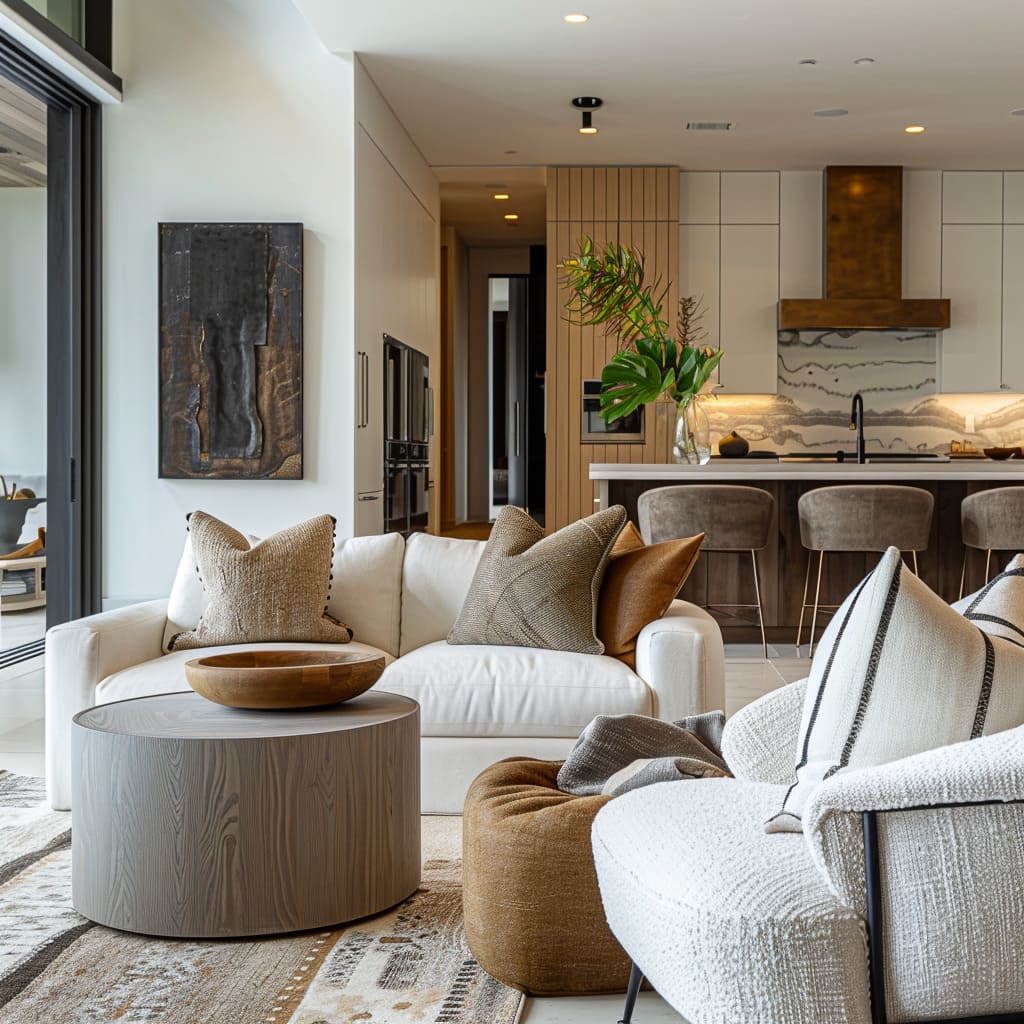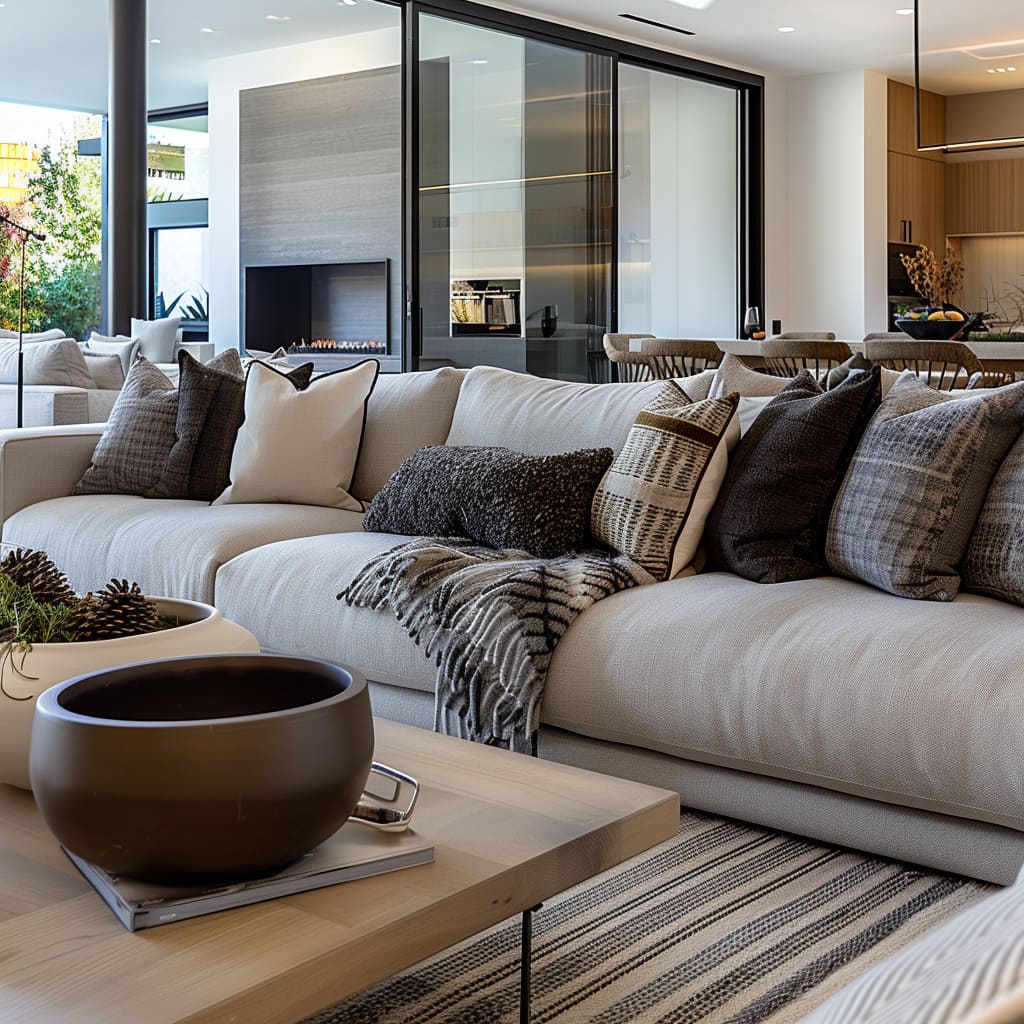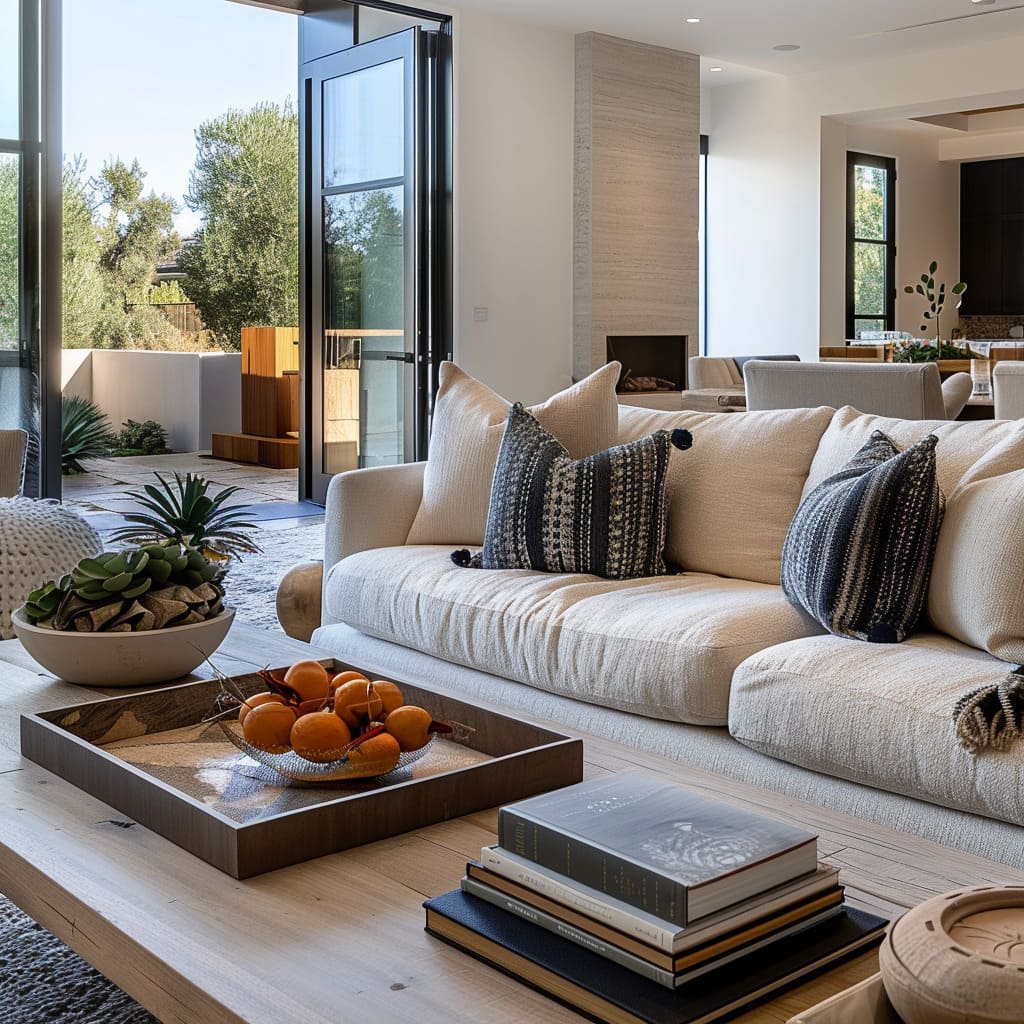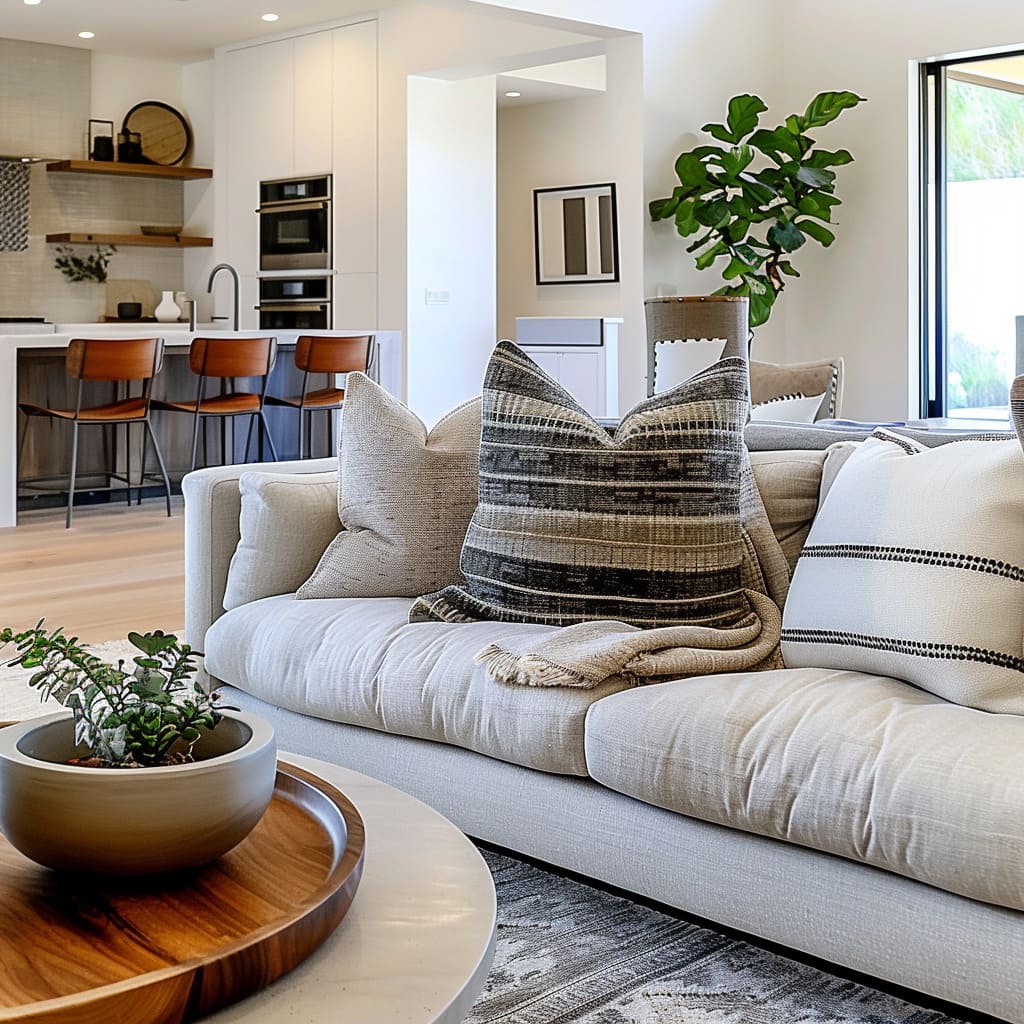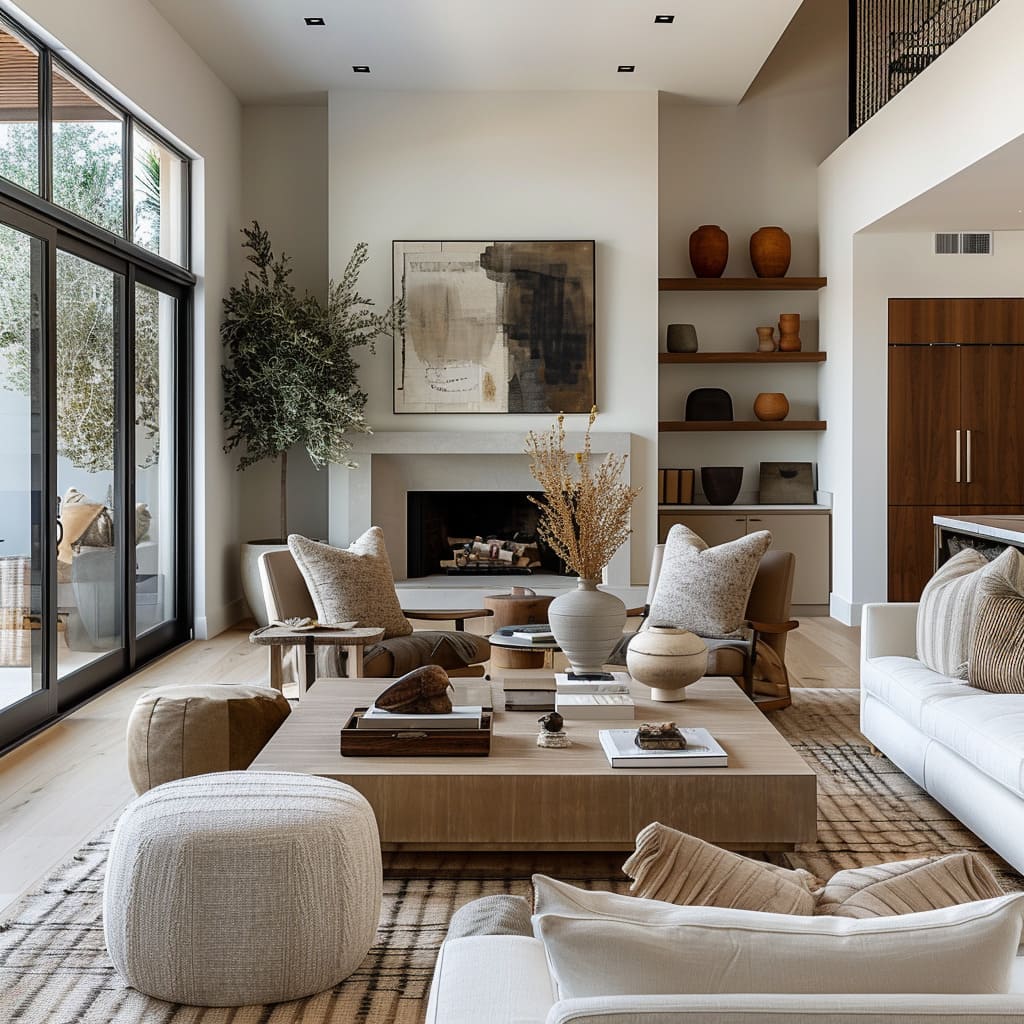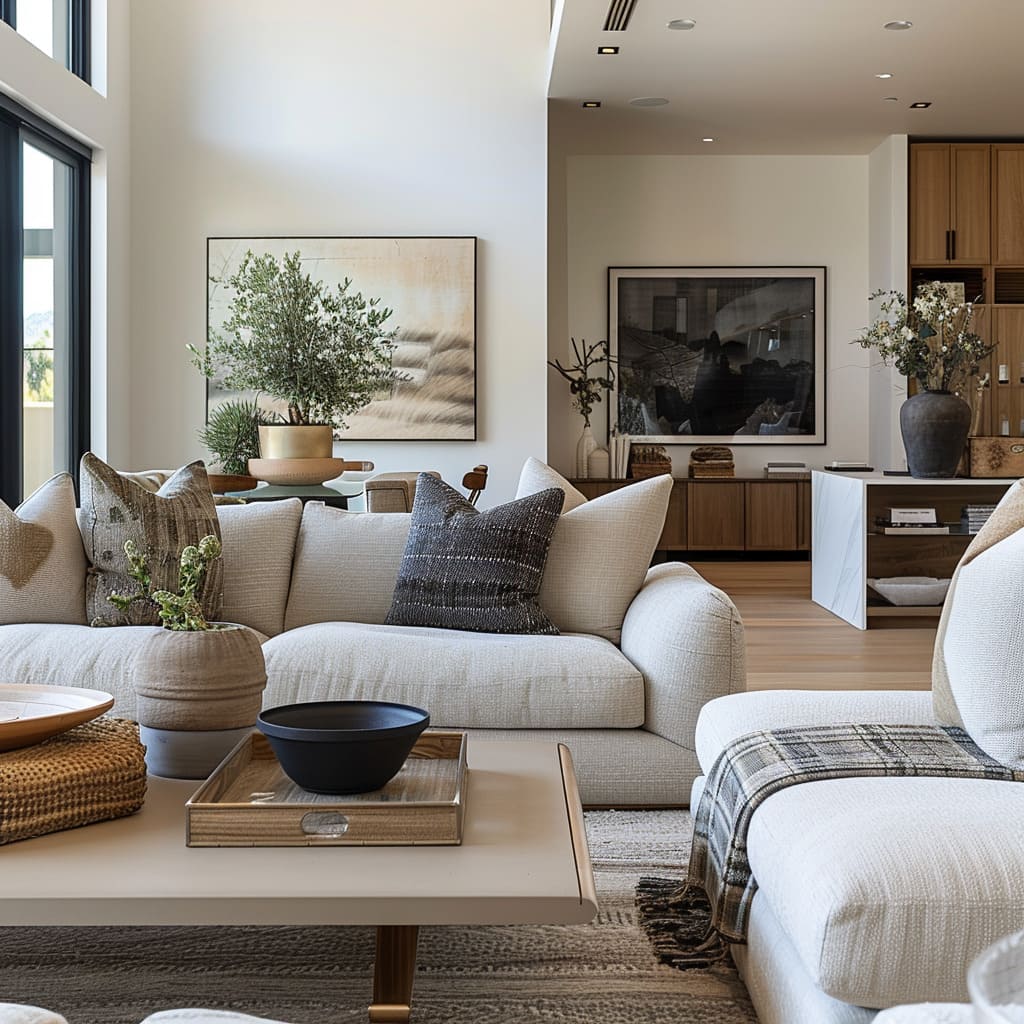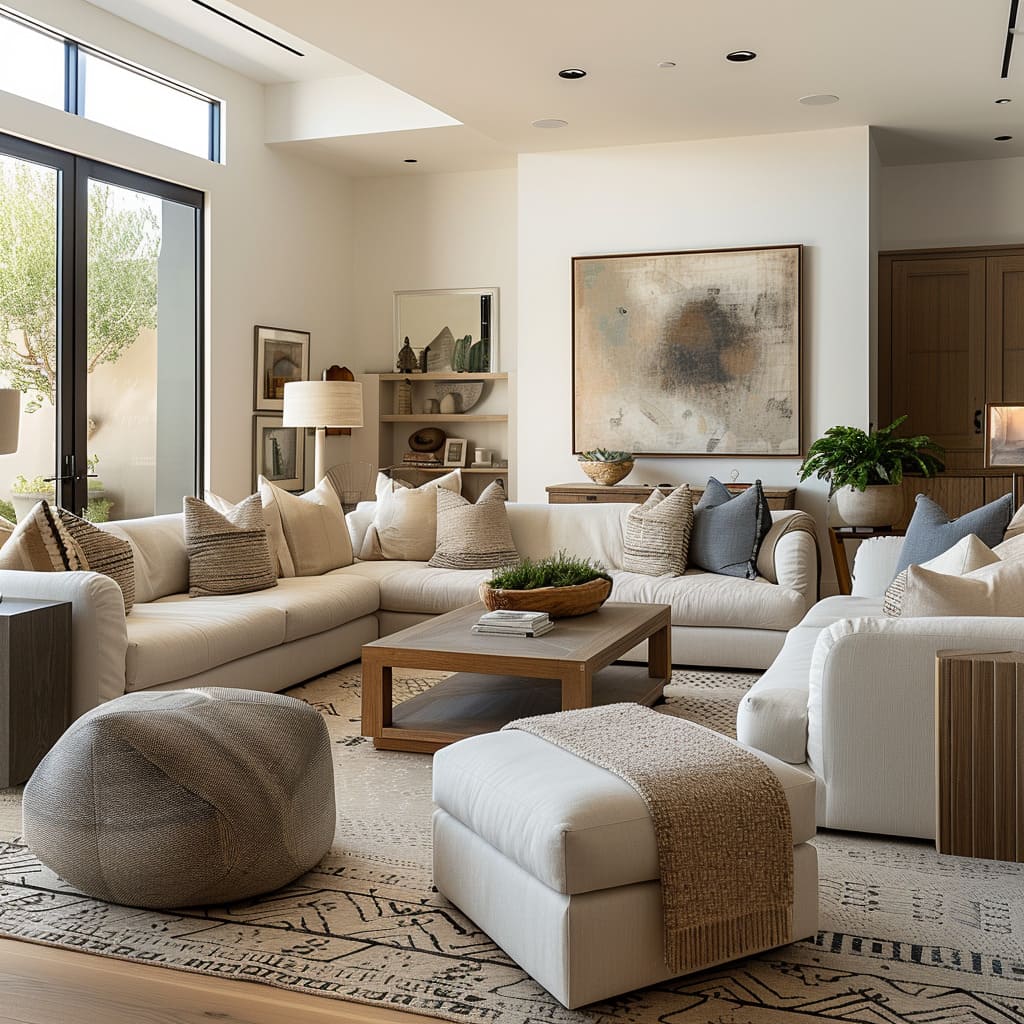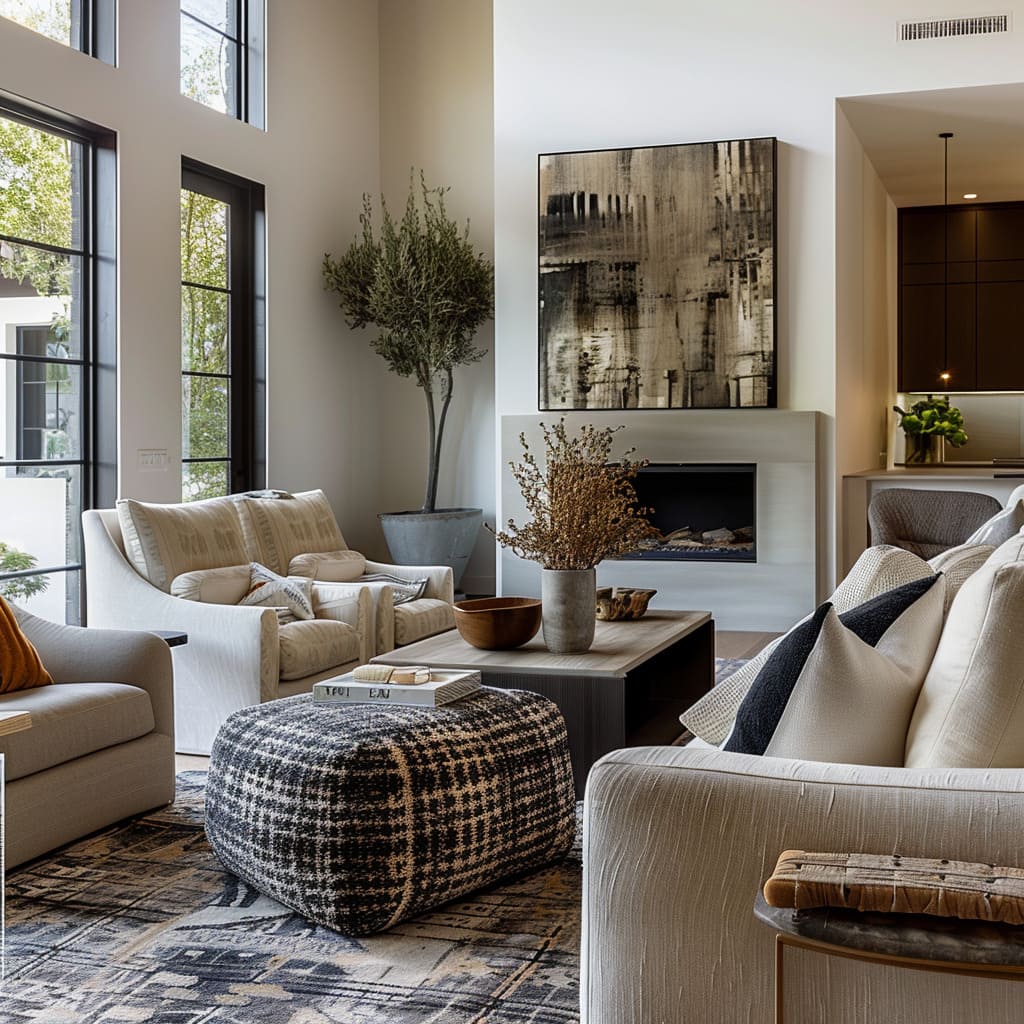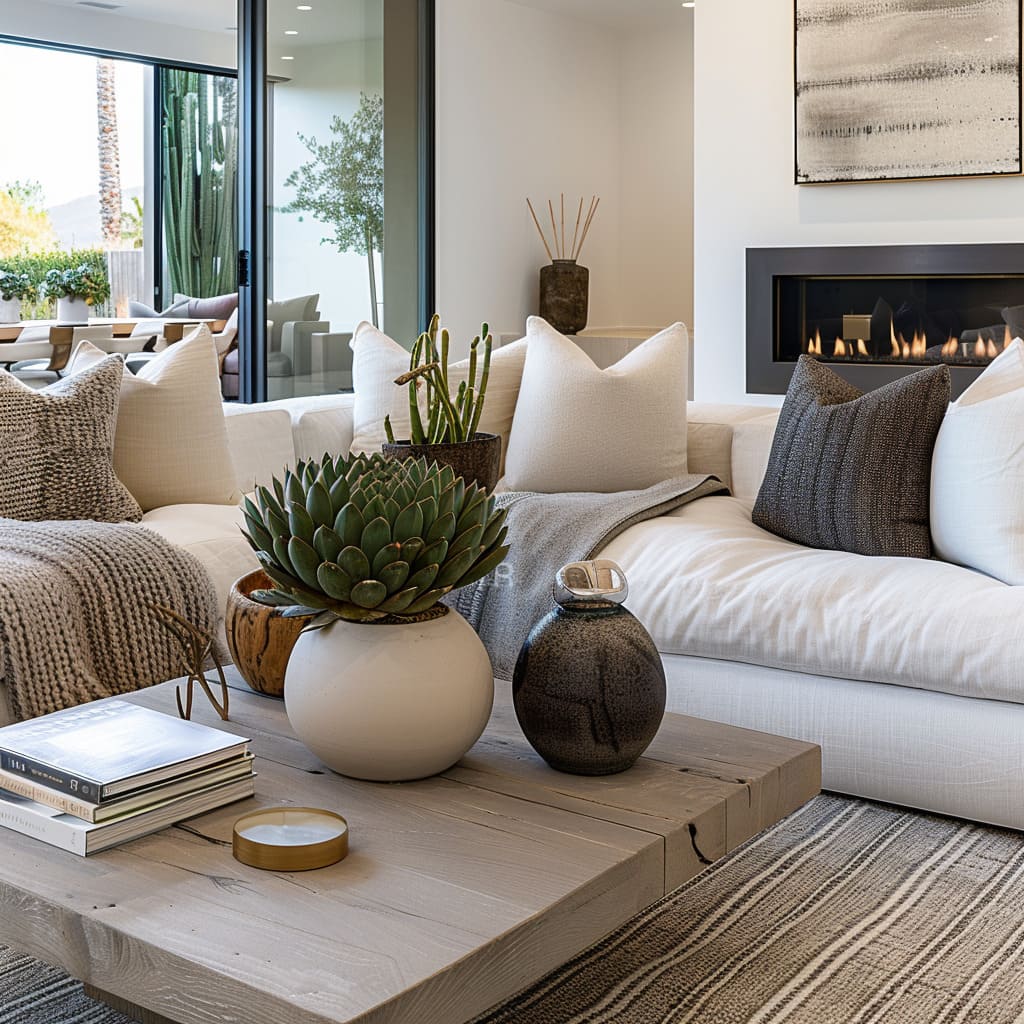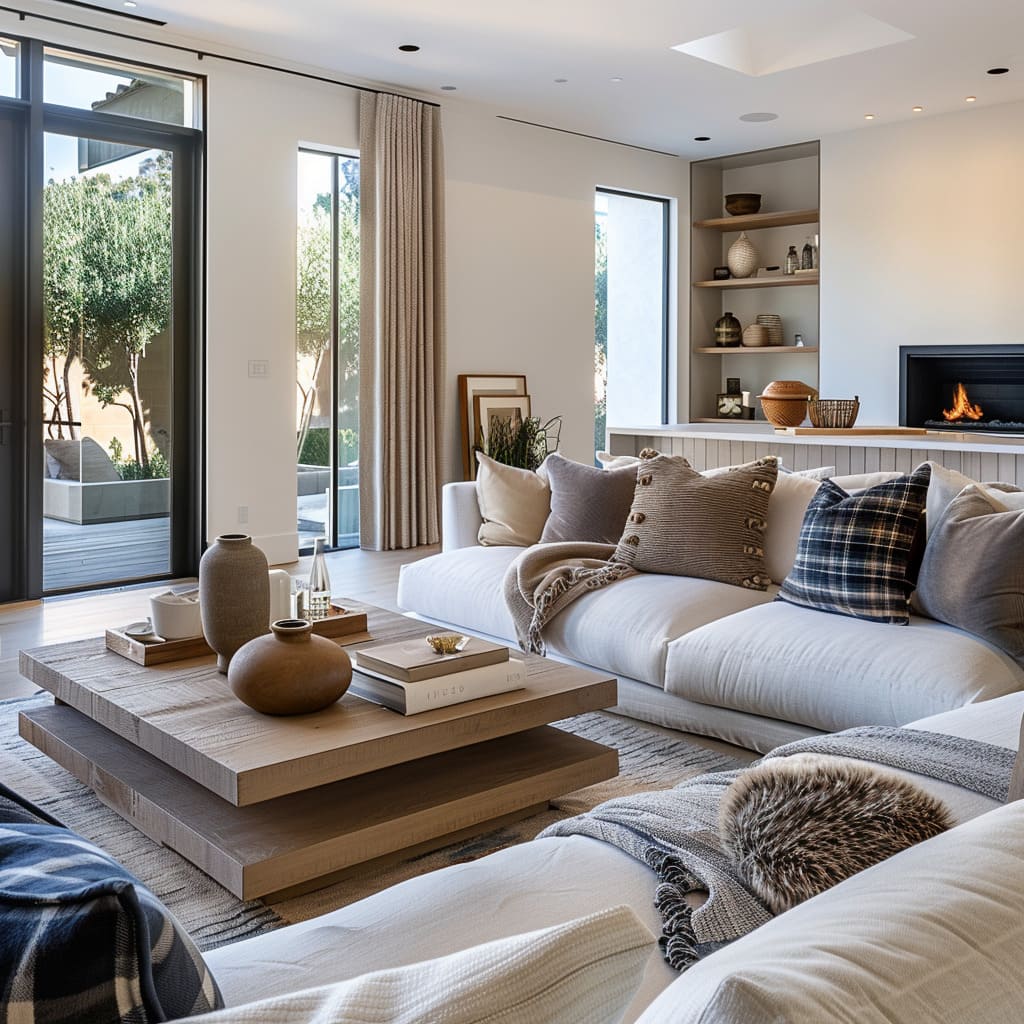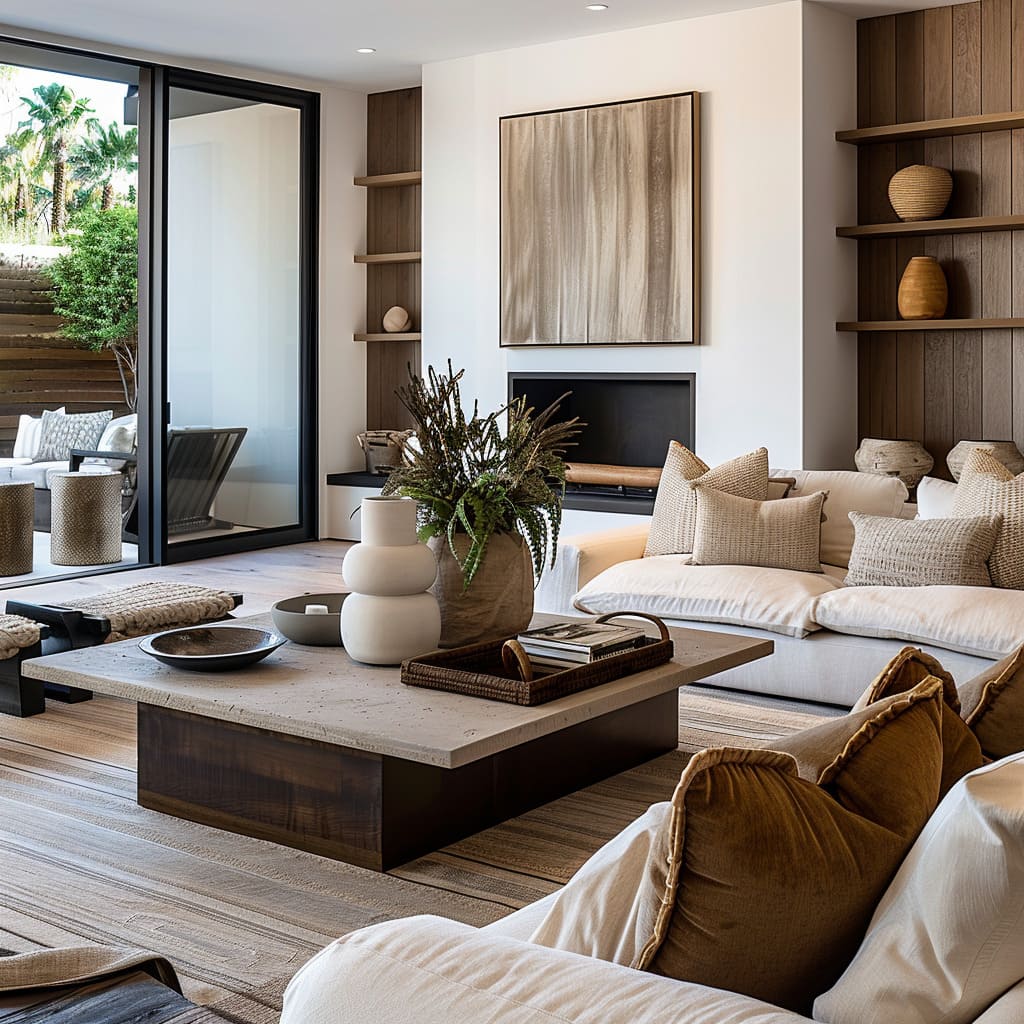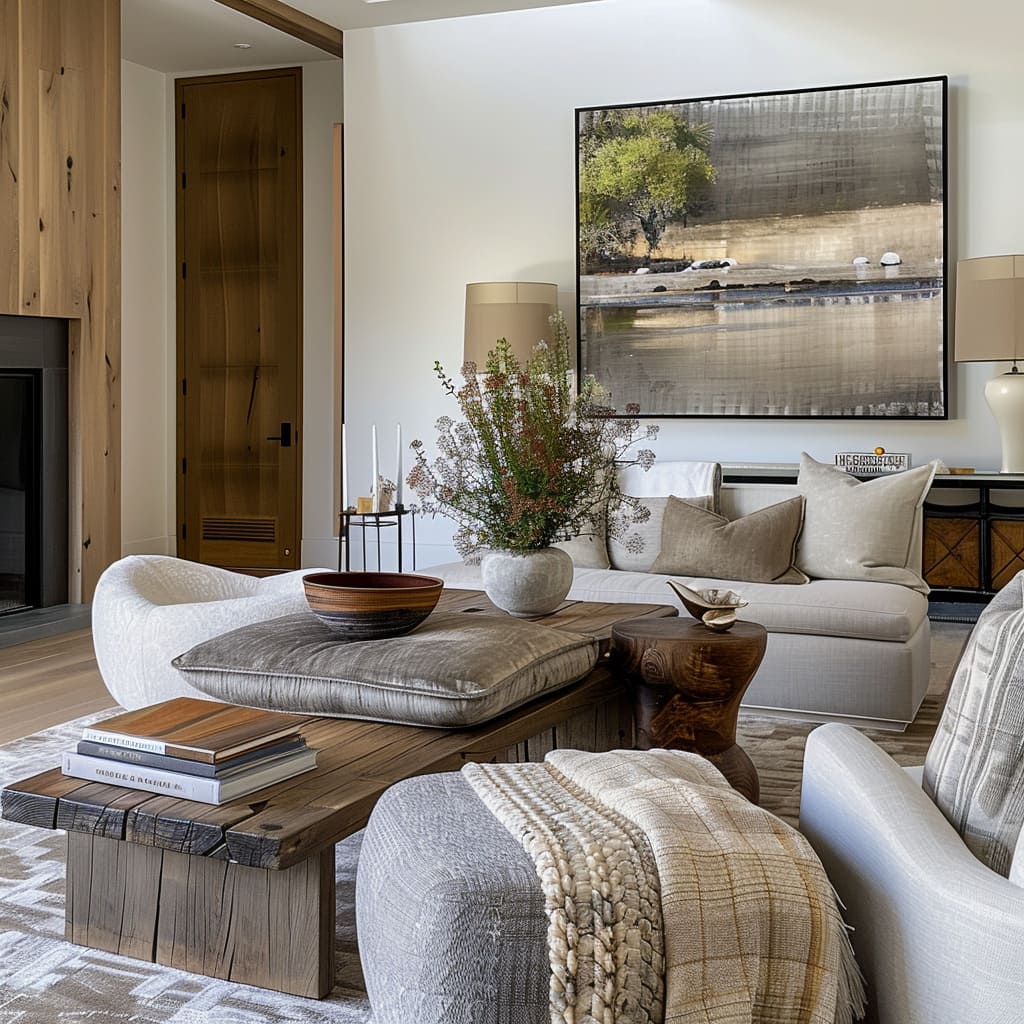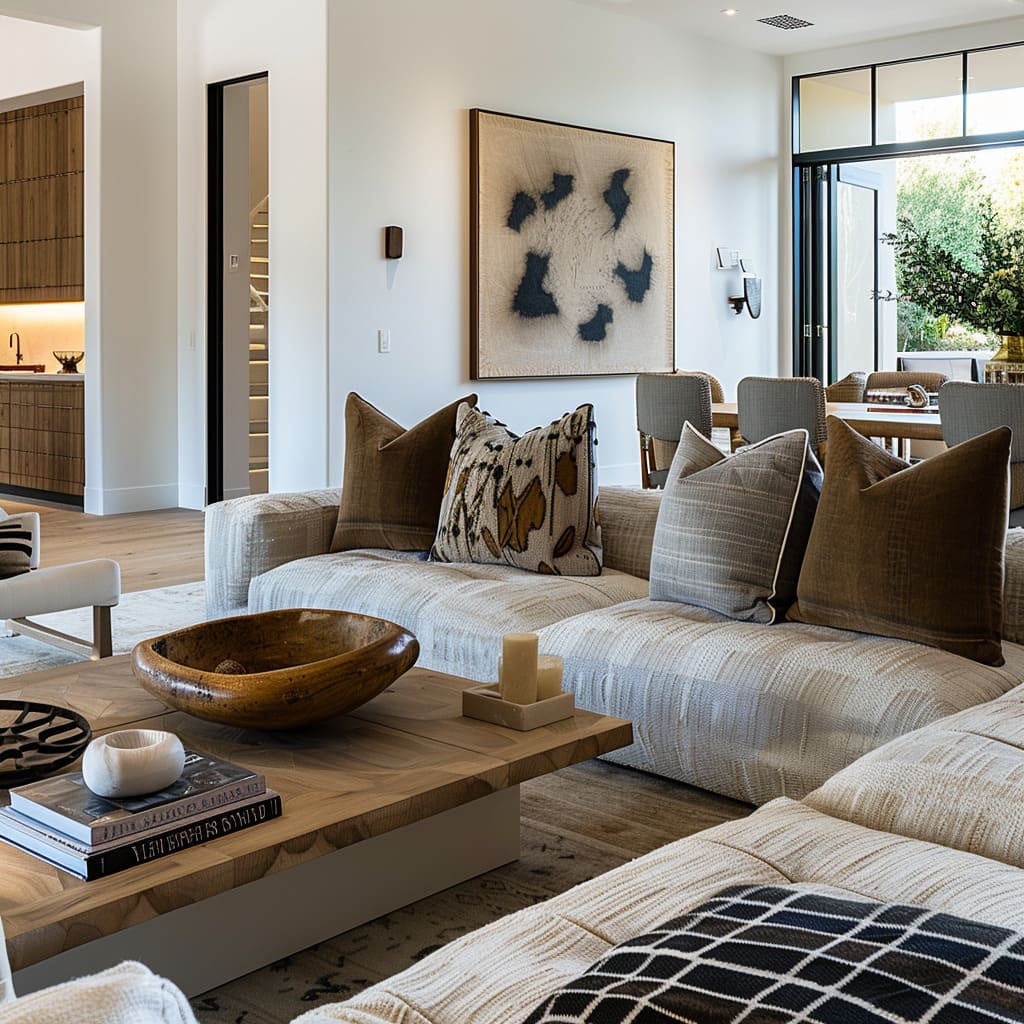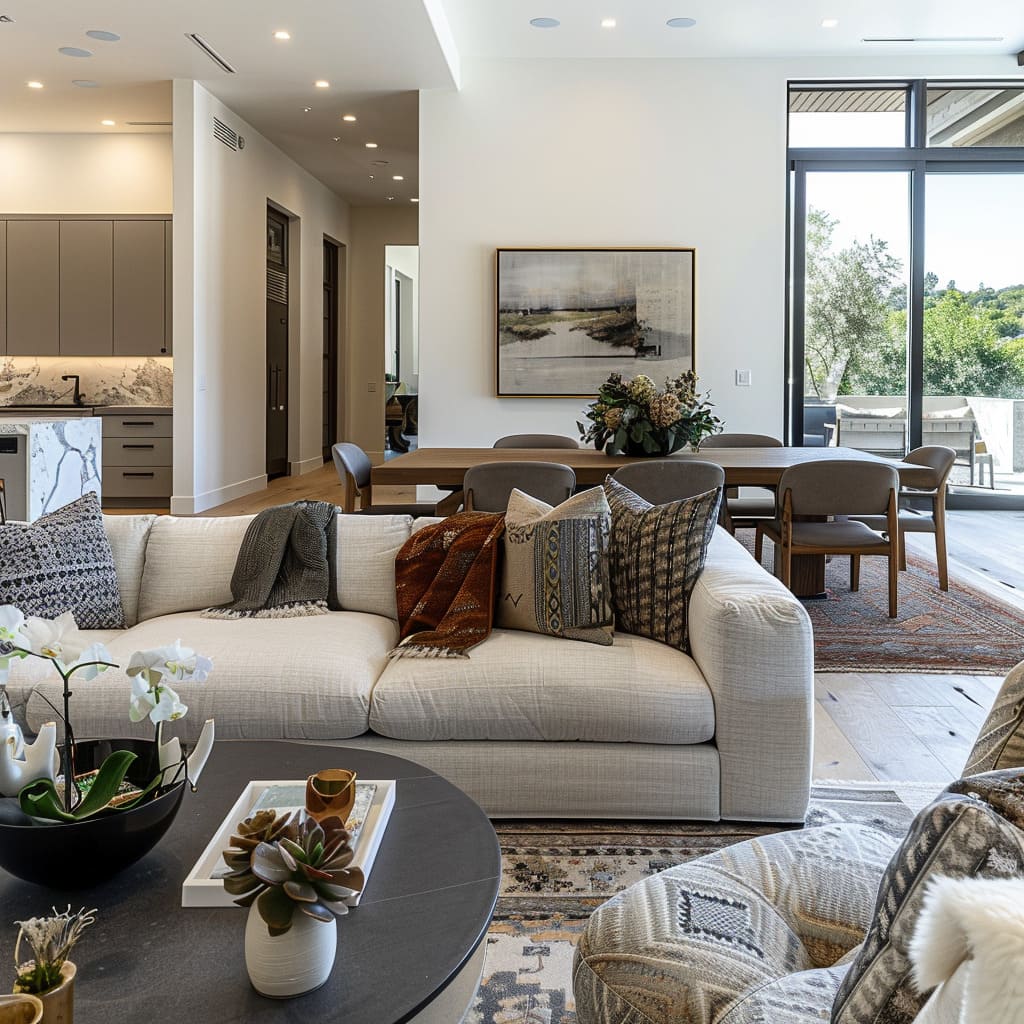In the quest to create spaces that are both aesthetically pleasing and deeply comfortable, interior design has evolved to embrace a philosophy that blends the best of functionality with the beauty of natural and modern elements. This article delves into the essence of a design style that harmonizes neutral color palettes with earth tones, incorporates natural materials for warmth, mixes textures for depth, and emphasizes the importance of open spaces for a minimalistic yet rich living experience.
We’ll explore how comfortable seating, modern furniture, and strategic use of decorative accents like throw blankets, pillows, pottery, and organic elements contribute to creating a home that is not just a place to live, but a sanctuary for relaxation and personal expression.
Neutral color palette & Earth tones
Beiges, whites, and grays dominate for a calming effect. These colors serve as a serene backdrop that reflects natural light and enhances the spacious feel of the rooms.
Walls, large furniture pieces, and floor coverings all adhere to this subdued palette, creating a cohesive and tranquil environment.
Occasionally accented with deeper hues like browns or muted greens, these colors draw inspiration from the outdoors, bringing an organic and grounding element to the space. Decorative elements such as pillows, throw blankets, and artwork introduce these richer tones subtly, without overwhelming the peaceful ambiance of the neutral setting.
To incorporate this feature into your interior, start with a base of neutral walls and a light-colored floor. Select major pieces of furniture in shades of beige or grey, and add depth with wooden or greenery accents.
For a cohesive look, ensure that the textures of these elements vary to create visual interest against the monochromatic scheme. Consider, for example, a soft grey sofa accented with pillows in earthy greens or rich browns.
Use natural materials like wood or stone for coffee tables and accent pieces, and add softness with woven rugs in complementary tones.
Natural materials
Wood, stone, and natural fibers are prominently featured, contributing to the overall warmth and authenticity of the design. Wooden elements are seen in exposed beams, polished floorboards, and handcrafted furniture, which provide an organic touch and a sense of timelessness.
Stone, often found in fireplace surrounds or as architectural details, adds texture and natural pattern. Natural fibers, observed in area rugs, baskets, and upholstery, offer a tactile quality that complements the solidity of wood and stone.
To effectively integrate natural materials into an interior, it’s essential to balance their use throughout the space. For instance, a wooden dining table can be paired with chairs featuring stone or metal accents to create contrast.
Floors can be adorned with natural fiber rugs, such as jute or sisal, which provide durability and add to the rustic charm. In living areas, consider adding a stone veneer to a feature wall or around a fireplace to bring a touch of rugged nature indoors.
Use baskets made from natural fibers for storage and decor to maintain the rustic yet refined aesthetic.
Mix of textures
A variety of fabrics, from smooth to coarse, for depth. The living rooms showcase a masterful layering of textures that adds sophistication and interest to the living spaces.
You can observe plush sofas adorned with a variety of throw pillows, each featuring different fabric types such as linen, knit, velvet, or patterned weaves. This blend of smooth and nubby materials invites touch and creates a lived-in feel that is both luxurious and comfortable.
Coarse textures in the form of woven baskets and rough-hewn wood pieces contrast with the sleeker surfaces like glass or polished metals, providing a visual and tactile balance.
To bring this mix of textures into your interior, consider starting with a foundational piece, like a sofa or an armchair, in a neutral, textured fabric. Build on this by adding cushions in a variety of materials – a knit throw, a velvet cushion, and perhaps a leather or faux fur pouf.
Incorporate accessories such as rattan baskets, chunky wool throws, or a sisal rug to enhance the textural dialogue. Remember to keep a balance so that no single texture overwhelms the space; instead, aim for a harmonious interplay that engages the senses and adds character to your home.
Open spaces
The layout is spacious with a minimalistic approach to avoid clutter. The living areas are characterized by an open floor plan that fosters a sense of freedom and fluidity.
There is a deliberate use of space that allows each piece of furniture and decor to stand out, contributing to the overall aesthetic without creating a congested environment.
The strategic placement of sofas, tables, and chairs facilitates easy movement and interaction, while the absence of superfluous furnishings ensures that the focus remains on the quality and design of each item. Ample space between furniture pieces gives the room a clean, uncluttered look that is both sophisticated and inviting.
To implement this open space concept in your interior, it is important to prioritize function and flow. Begin by choosing only essential furniture that serves a purpose and contributes to the overall design.
Arrange these pieces to create distinct areas within the room — a seating area, a reading nook, or a space for entertainment.
Ensure there is generous walking space around furniture groupings to maintain an unobstructed flow. Use sleek, built-in storage to keep items out of sight and maintain the open feel.
Embrace natural light by minimizing window treatments, or choose sheer, light fabrics that do not overwhelm the windows.
Comfortable seating
Plush sofas and chairs for relaxation. The seating is carefully selected to provide maximum comfort without sacrificing style.
Oversized sofas with deep cushions invite occupants to sit back and unwind, while accent chairs with soft, enveloping shapes offer additional cozy seating options. The use of luxurious, touchable fabrics on these pieces further enhances the comfort factor, making the living room a place where one could easily linger for hours.
The seating is not only ample but also arranged to facilitate conversation and interaction, underscoring the living room’s role as a social hub.
To create a similar atmosphere of comfortable seating in your home, start with a high-quality sofa that offers both support and softness. Look for one with a generous depth and plush cushions.
Layer it with throw pillows and blankets for added softness and warmth. Select additional seating like armchairs or a love seat that complements the sofa both in comfort and style.
Arrange the seating to face each other to encourage conversation, and if space allows, incorporate a chaise or a daybed for lounging. Choose upholstery fabrics that are soft to the touch but also durable, such as heavy cotton, velvet, or microfiber, to ensure your seating is as practical as it is comfortable.
Modern furniture
Clean lines and shapes for a contemporary look. The furniture pieces embody a sleek and minimalist aesthetic, devoid of unnecessary embellishments.
Sofas and chairs with streamlined silhouettes are paired with low-profile coffee tables and sideboards that reflect a modern sensibility. The use of metal legs on furniture, slim-profiled shelving, and unadorned cabinetry emphasizes a look that is at once current and timeless.
This modernity is softened by the choice of materials like wood and the inclusion of cozy textiles, which ensure the spaces feel welcoming rather than austere.
To incorporate modern furniture into your space, select pieces with simple yet strong lines that serve as the room’s focal points. Choose a sofa with a straightforward, elegant profile as the centerpiece.
Pair it with a geometric coffee table or side tables that feature a mix of materials like glass and metal for that modern edge. Consider functionality and opt for pieces that offer clean aesthetics without compromising on comfort or utility.
For instance, modular units or built-in shelving that follow a straight, clean design can be both practical and stylish, offering a contemporary look while keeping with the minimalist theme.
Throw blankets and pillows
For added comfort and aesthetic appeal. The interiors depicted illustrate the thoughtful placement of throw blankets and pillows, which serve as the perfect marriage of form and function.
The throws are casually draped over the backs of sofas and chairs, suggesting an inviting, lived-in quality that encourages one to curl up and relax. Pillows are chosen not just for comfort but also to introduce subtle patterns, textures, and a dash of color that complements the room’s neutral scheme.
They vary in size and shape, adding visual interest and depth to the seating areas.
To enhance your own space with throw blankets and pillows, select items that resonate with the room’s color palette while introducing different textures or patterns. Mix and match pillow sizes for a layered, designer look, and choose throws in luxurious materials like wool, cotton, or cashmere for an element of indulgence.
Keep a throw on the arm of a sofa or the edge of a chaise to pull over your lap on cooler evenings, adding both warmth and a welcoming touch.
Neutral-toned pottery and vases
For rustic touches that also serve as functional decor. The living rooms feature an array of neutral-toned pottery and vases, which blend seamlessly into the decor while providing an earthy, artisanal counterpoint to the modern furnishings.
These pieces are crafted in organic shapes and textures that reflect the natural world, often in materials like ceramic, clay, or stone. They can be found throughout the living spaces, sometimes empty as sculptural pieces, other times filled with simple greenery or branches to add a touch of life.
Incorporating such elements into your interior can be done by selecting a variety of neutral-toned pottery and vases that speak to the rustic farmhouse aesthetic. Group them together for a collected look, or place individual pieces strategically to create points of interest.
They can serve as centerpieces for tables or be placed on open shelving as part of a curated display. Choose items that are beautiful in their simplicity and that can stand alone as works of art.
When using them as vases, opt for simple arrangements that do not compete with the beauty of the vessel.
Exposed wooden beams
They add a rustic charm and architectural interest. The designs reveal that the ceilings are graced with exposed wooden beams, a feature that draws the eye upward and adds dimension to the rooms.
These beams are a nod to traditional craftsmanship and bring warmth to the otherwise modern aesthetics of the spaces. Their natural texture and color provide a contrast to the smooth, painted surfaces of the walls, creating a dynamic interplay between old and new design elements.
Beyond their aesthetic appeal, these beams also suggest structural integrity and longevity, grounding the space in a sense of history and stability.
To introduce exposed wooden beams into your interior, consider whether your space has the potential to expose existing beams. If not, faux beams can be installed to achieve a similar look.
Select a wood tone that harmonizes with your furniture and flooring for a cohesive design. The beams can be substantial and rough-hewn for a more traditional, rustic feel, or more refined and polished to suit a modern-rustic decor.
Their placement should be deliberate, accentuating the highest points of the room or framing specific areas like a dining space or a cozy seating arrangement.
Discover how modern rustic architectural elements shape contemporary farmhouse styles by reading our comprehensive exploration of exterior designs.
Organic elements
Driftwood, stones, and other natural elements as decor pieces. The living spaces are accentuated with organic decor elements that bring an outdoor essence into the home.
Pieces of driftwood, smooth stones, and other natural elements are used as unique, earthy accents that lend authenticity and a bespoke feel to the interiors.
These items are often displayed as centerpieces on tables or placed on shelves among books and other curated objects, their irregular and intriguing shapes providing visual and tactile interest. They serve as a reminder of the natural world and contribute to a serene and grounded atmosphere within the home.
To incorporate organic elements into your space, look for unique natural items that can serve as conversation starters. A piece of driftwood can become a sculptural element on a mantel or coffee table.
Smooth river stones or crystals can be arranged in a bowl as a tactile decorative piece.
When selecting these items, consider their scale and how they will fit within your existing decor. They should be proportionate to the space and the furniture around them.
By including these elements, you bring a touch of nature’s unpredictability and beauty into the structured environment of a home.
Layered look
Through the use of various textiles and materials. The layered approach is achieved through a deliberate selection and placement of textiles and materials that add depth and interest to the spaces.
Rugs atop rugs layer texture on the floor, while various fabrics on cushions, throws, and window treatments create a rich tapestry of surfaces that are pleasing to the eye and touch.
The layering extends to the mix of materials like wood with metal and glass, which are used in furniture and decorative items. This interplay of different textures and finishes gives the room a sophisticated and collected feel over time, indicative of a well-traveled and curated space.
To replicate this layered look in your interior, start with a base layer such as a large area rug and consider layering a smaller, more textured rug on top. Introduce a variety of fabric textures through your choice of throw pillows, mixing materials such as cotton, linen, wool, and silk.
Ensure your curtains or drapes add to the layering effect with a texture or sheer material that complements the other textiles in the room.
When selecting furniture and accent pieces, combine different materials such as a wooden coffee table with a metal frame or a glass top, and metal or ceramic side tables. The key is to create a sense of harmony through diversity, allowing each layer to contribute to a cohesive whole without any one material or texture overpowering the others.
Large windows
To let in natural light and often maximize the view of the surrounding landscape. The interiors showcase expansive windows that flood the interiors with daylight, illuminating the neutral color palette and enhancing the overall airy feel of the spaces.
These windows not only serve to brighten the room but also act as a bridge to the outdoors, framing the picturesque views and inviting them into the home.
The strategic use of window treatments, often sheer or absent altogether, underscores a design that prioritizes a connection with the environment, blurring the lines between inside and outside.
To incorporate large windows into your interior, focus on window treatments that allow light to penetrate while offering privacy when needed. Consider retractable shades or light, gauzy curtains that can be easily pulled back to expose the full window.
If you’re planning a renovation or new construction, think about the orientation of your home and place windows to capture the best views and sunlight. Use windows as the focal point of your room and arrange furniture to either face or complement the window, ensuring the outdoor scenery becomes an integral part of your living space.
Coffee tables
Practical, often wooden, and in harmony with the style. Coffee tables are central to the living spaces, both as functional surfaces and as aesthetic statements.
They are often constructed from wood, contributing to the natural, earthy feel of the room, and their designs are clean and simple, which aligns with the contemporary rustic theme. These tables are not just standalone pieces; they’re styled thoughtfully with books, decorative bowls, or vases, which adds to their practicality and visual appeal.
To integrate coffee tables into your space in a similar fashion, select a table that speaks to the room’s style and your personal needs. A wooden table can anchor the space, but consider its finish and shape — a raw, natural finish can add a more rustic touch, while a polished surface can lean towards the contemporary.
Style the table with items that are both beautiful and useful, such as a stack of art books or a tray for holding remotes and coasters.
Ensure there’s still plenty of space to use the table functionally, whether for holding drinks, displaying flowers, or providing a footrest. The coffee table should serve as a versatile centerpiece that ties the room together.
Through the lens of contemporary rustic design, we have journeyed through the critical components that make a living space not just visually appealing, but also a haven of comfort and tranquility. The harmonious blend of neutral hues, the strategic use of natural materials and textures, and the purposeful arrangement of furniture all play a pivotal role in crafting an environment that’s both inviting and stylish.
Large windows draw in the beauty of the natural world, while coffee tables and layered decor items add practical elegance. Whether you are revamping a single room or reimagining your entire home, the principles outlined in this article provide a roadmap for cultivating a living space that is timeless, sophisticated, and imbued with a sense of peacefulness.
Embrace these elements to create a home that is not only in step with contemporary design trends but also resonates with your unique aesthetic and lifestyle needs.

